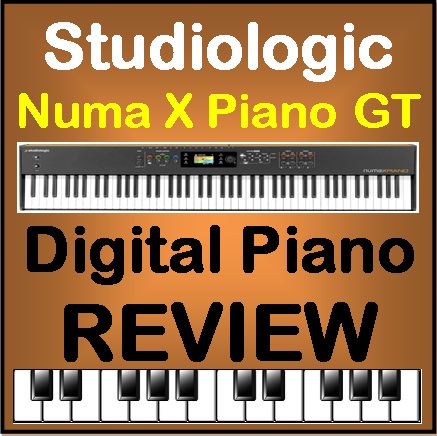
REVIEW – Studiologic Numa X Piano GT | 2025 Stage & Studio Digital Piano | $2199 internet price – This newer Studiologic stage piano model is called the Numa X Piano GT. After playing it for many days and hours I can say that I am very impressed with what it can do and how it plays as a piano along with its vast array of quality internal non-piano instrumental sounds and effects.
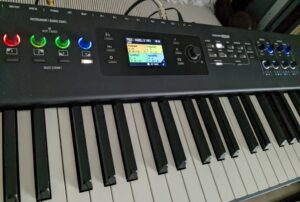 If you are a pro keyboard or stage digital piano player and/or you work in a recording studio then you likely know the name “Studiologic.” But…if you are a amateur musician playing at home, church, school, or at small individual gigs, or you are a piano student or acoustic piano player, then you may not have heard of this brand before.
If you are a pro keyboard or stage digital piano player and/or you work in a recording studio then you likely know the name “Studiologic.” But…if you are a amateur musician playing at home, church, school, or at small individual gigs, or you are a piano student or acoustic piano player, then you may not have heard of this brand before.WHO IS STUDIOLOGIC?

 It is well known by music industry people that Fatar builds key actions for other digital piano & keyboard brands such as Nord, Kurzweil, and Dexibell, among others. The Fatar company has their own keyboard/digital piano brand called “Studiologic” which they began producing in 1986. So whenever you see a Studiologic instrument, it is really from the Fatar company of Italy.
It is well known by music industry people that Fatar builds key actions for other digital piano & keyboard brands such as Nord, Kurzweil, and Dexibell, among others. The Fatar company has their own keyboard/digital piano brand called “Studiologic” which they began producing in 1986. So whenever you see a Studiologic instrument, it is really from the Fatar company of Italy.INITIAL THOUGHTS
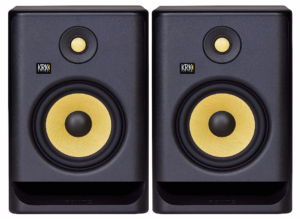 But since I have high quality studio monitors/speakers in my teaching & recording studio, then that’s not an issue for me. Plus, I always test out these digital pianos with good stereo headphones as well. My primary purpose in trying out this newer model is that I have been hearing some very good things about it in its lower price range of under $2000. I personally wanted to see if it could actually come close to reproducing a solid and more realistic piano playing experience which is important to me, along with the other instrumental sounds that it offers.
But since I have high quality studio monitors/speakers in my teaching & recording studio, then that’s not an issue for me. Plus, I always test out these digital pianos with good stereo headphones as well. My primary purpose in trying out this newer model is that I have been hearing some very good things about it in its lower price range of under $2000. I personally wanted to see if it could actually come close to reproducing a solid and more realistic piano playing experience which is important to me, along with the other instrumental sounds that it offers.THE NAME – STUDIOLOGIC NUMA X PIANO GT

 This new top-of-the-line model has the letters “GT” added to signify this one has the new Studiologic “GrandTouch” TP/400 Wood key action. This specific GrandTouch key action is far superior to and completely different than the other Studiologic model Numa X Piano 88 and any other Fatar models with the GrandTouch name or logo. Fatar/Studiologic uses this generic “GrandTouch” name, but the actual key action is called TP/400 Wood and that’s the most important part of the key action name. I will be talking about this new GT key action below, but that’s what the “GT” part of the model number is all about.
This new top-of-the-line model has the letters “GT” added to signify this one has the new Studiologic “GrandTouch” TP/400 Wood key action. This specific GrandTouch key action is far superior to and completely different than the other Studiologic model Numa X Piano 88 and any other Fatar models with the GrandTouch name or logo. Fatar/Studiologic uses this generic “GrandTouch” name, but the actual key action is called TP/400 Wood and that’s the most important part of the key action name. I will be talking about this new GT key action below, but that’s what the “GT” part of the model number is all about.KEY ACTION – WHAT IT’S LIKE
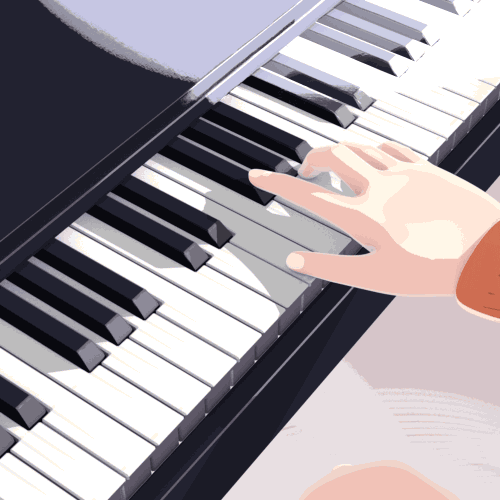 Since key action is the most important component in any digital piano, I am spending a good amount of time talking about this subject here. When it comes to key actions in stage digital pianos, they can vary quite a bit. It just depends on the brand and model of that piano. I have played many stage pianos that have springy key actions which feel more like keyboard key actions than piano. Other key actions I have played can feel very stiff or sluggish. Other than Fatar/Studiologic, the primary brands who make stage digital pianos include Kawai, Yamaha, Roland, Casio, Korg, Kurzweil, and Nord,
Since key action is the most important component in any digital piano, I am spending a good amount of time talking about this subject here. When it comes to key actions in stage digital pianos, they can vary quite a bit. It just depends on the brand and model of that piano. I have played many stage pianos that have springy key actions which feel more like keyboard key actions than piano. Other key actions I have played can feel very stiff or sluggish. Other than Fatar/Studiologic, the primary brands who make stage digital pianos include Kawai, Yamaha, Roland, Casio, Korg, Kurzweil, and Nord,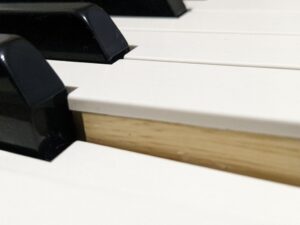 Studiologic calls this key action its TP-400W “GrandTouch” as I previously mentioned. This description would give you the impression that it has the touch of an acoustic grand piano. In a way it does and in a couple of ways it definitely does not. Actual Grand piano keys are all 100% wood inside the key. The GT key-action has wooden sides on the white keys to give the white keys more strength and durability along with making the sides of those keys look more realistic. But they are not 100% wooden keys. The black keys of the GT key action are all plastic which is fine and I was expecting that.
Studiologic calls this key action its TP-400W “GrandTouch” as I previously mentioned. This description would give you the impression that it has the touch of an acoustic grand piano. In a way it does and in a couple of ways it definitely does not. Actual Grand piano keys are all 100% wood inside the key. The GT key-action has wooden sides on the white keys to give the white keys more strength and durability along with making the sides of those keys look more realistic. But they are not 100% wooden keys. The black keys of the GT key action are all plastic which is fine and I was expecting that.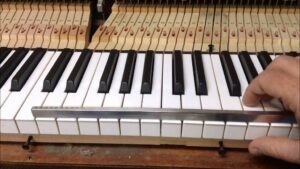 Actual acoustic grand piano keys are very long in length inside of a grand piano. The white keys of a grand piano can be about 19″ long and they get much longer than that as the grand piano gets larger, such as concert grand pianos. The Studiologic GT actions have much shorter keys than real grand pianos (all normal digital pianos have shorter keys than grand pianos) and the keys are not 100% wood like acoustic pianos (as I just mentioned), so the balance and fulcrum points of those keys are not the same as grand pianos.
Actual acoustic grand piano keys are very long in length inside of a grand piano. The white keys of a grand piano can be about 19″ long and they get much longer than that as the grand piano gets larger, such as concert grand pianos. The Studiologic GT actions have much shorter keys than real grand pianos (all normal digital pianos have shorter keys than grand pianos) and the keys are not 100% wood like acoustic pianos (as I just mentioned), so the balance and fulcrum points of those keys are not the same as grand pianos.KEY WEIGHT
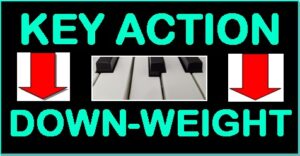 The actual weight of the GT white keys going down and coming back up feels very good overall. This is called static down-weight and upweight force as measured in grams. The white keys are especially impressive in their key weight and movement for a model in this price range. The amount of force it takes for your finger to press down the middle C key towards the front of the key, which is called static down-weight (aka: touch-weight), is about 57 to 60 grams of force. On a good grand piano it averages about 50 to 60 grams of finger force to play the middle C key, so the XGT key action is in a very good and comfortable range.
The actual weight of the GT white keys going down and coming back up feels very good overall. This is called static down-weight and upweight force as measured in grams. The white keys are especially impressive in their key weight and movement for a model in this price range. The amount of force it takes for your finger to press down the middle C key towards the front of the key, which is called static down-weight (aka: touch-weight), is about 57 to 60 grams of force. On a good grand piano it averages about 50 to 60 grams of finger force to play the middle C key, so the XGT key action is in a very good and comfortable range.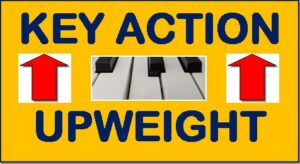 The return force of the keys when they return to its resting position after pressing them down is also important because those keys need to come back quickly and responsively without being too sluggish or coming back way to hard. This is called up-weight and the upweight on the XGT middle C key is about 30 grams based on my measurements.
The return force of the keys when they return to its resting position after pressing them down is also important because those keys need to come back quickly and responsively without being too sluggish or coming back way to hard. This is called up-weight and the upweight on the XGT middle C key is about 30 grams based on my measurements.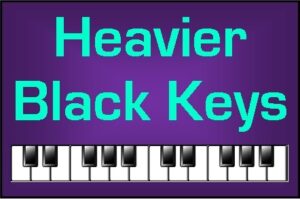 As for the black keys, they are heavier (firmer) than I would like to see. The middle C# key weight force measures are at about 77 grams of down-weight force and about 23 grams for the up-weight force of the middle C# key, based on my measurements. This would mean that it takes noticeably more force for the fingers to play on the black keys as opposed to the white keys. This is not necessarily unusual for some digital piano key actions and I have seen this before.
As for the black keys, they are heavier (firmer) than I would like to see. The middle C# key weight force measures are at about 77 grams of down-weight force and about 23 grams for the up-weight force of the middle C# key, based on my measurements. This would mean that it takes noticeably more force for the fingers to play on the black keys as opposed to the white keys. This is not necessarily unusual for some digital piano key actions and I have seen this before.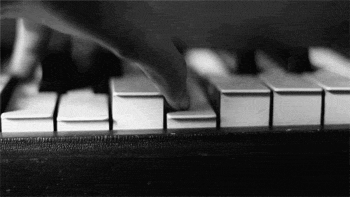 But as far as perfection goes, the closer the white and black keys are to each other when it comes to key movement upweight and down-weight force, the better. Having the black keys be heavier than the white keys is not necessarily a bad thing and some people actually like it that way. It’s better than having the black keys be noticeably lighter in weight than the white keys. But I would have preferred if the black keys were less heavy and closer to the white keys for their weight and key movement. Nevertheless, this TP/400 wood key action is definitely playable and overall I do enjoy playing it
But as far as perfection goes, the closer the white and black keys are to each other when it comes to key movement upweight and down-weight force, the better. Having the black keys be heavier than the white keys is not necessarily a bad thing and some people actually like it that way. It’s better than having the black keys be noticeably lighter in weight than the white keys. But I would have preferred if the black keys were less heavy and closer to the white keys for their weight and key movement. Nevertheless, this TP/400 wood key action is definitely playable and overall I do enjoy playing itKEY ACTION “ESCAPEMENT”
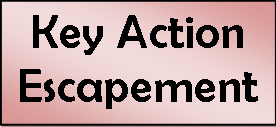 The key action also has a feature built into it called “escapement” (aka: let-off). This is a function of acoustic grand pianos where there is a noticeable notch or hesitation of the keys as you press the keys about half-way down and play lightly and slowly on a grand piano. Some players like this feeling because it gives their fingers a physical guide as to how fast (or slow) the keys are moving when you feel this “notch” feeling when playing the keys slowly and lightly.
The key action also has a feature built into it called “escapement” (aka: let-off). This is a function of acoustic grand pianos where there is a noticeable notch or hesitation of the keys as you press the keys about half-way down and play lightly and slowly on a grand piano. Some players like this feeling because it gives their fingers a physical guide as to how fast (or slow) the keys are moving when you feel this “notch” feeling when playing the keys slowly and lightly.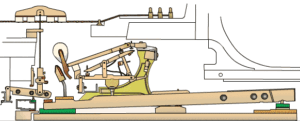 However, you definitely don’t feel this slight hesitation (notch) in the movement of grand piano keys when you are playing at medium speed/key force or harder. It’s only felt when you play softly that you can feel it. This key action feature is nice to have, but in a stage digital piano it is not necessarily a deal-breaker in my opinion if it doesn’t have this feature. It won’t change the weight or overall movement of the keys. But for some people they may appreciate having it and will use it accordingly.
However, you definitely don’t feel this slight hesitation (notch) in the movement of grand piano keys when you are playing at medium speed/key force or harder. It’s only felt when you play softly that you can feel it. This key action feature is nice to have, but in a stage digital piano it is not necessarily a deal-breaker in my opinion if it doesn’t have this feature. It won’t change the weight or overall movement of the keys. But for some people they may appreciate having it and will use it accordingly.IVORY-FEEL KEYS
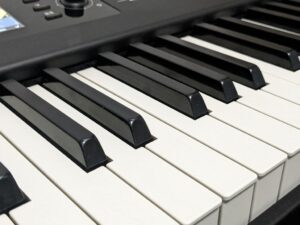 The white keytops have a synthetic ivory material on them (ivory-feel) and it feels great. Not too textured and not too slippery…just right. It also makes the keys look a bit classier that way and better than just all-plastic keytops as some stage pianos have. The black keys have a smooth black matte finish on them which also feels nice and looks good too. So when it comes to a responsive dynamic key movement and overall comfort, Fatar/Studiologic did a good job with this new key action, especially in this lower price range.
The white keytops have a synthetic ivory material on them (ivory-feel) and it feels great. Not too textured and not too slippery…just right. It also makes the keys look a bit classier that way and better than just all-plastic keytops as some stage pianos have. The black keys have a smooth black matte finish on them which also feels nice and looks good too. So when it comes to a responsive dynamic key movement and overall comfort, Fatar/Studiologic did a good job with this new key action, especially in this lower price range.TRIPLE SENSOR KEY ACTION RESPONSE
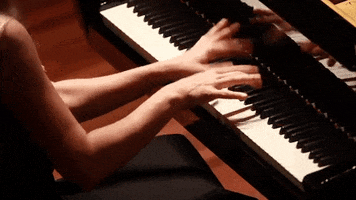 One more thing. Digital piano key actions can have either 1, 2, or 3 electronic key sensors under each key. Sensors is what the keys need to activate the sound you hear. Having 3 high quality key sensors under each key is very important, especially for more advanced piano players. The additional key sensors for a triple sensor key action helps with having better note response when playing faster and with more repetition.
One more thing. Digital piano key actions can have either 1, 2, or 3 electronic key sensors under each key. Sensors is what the keys need to activate the sound you hear. Having 3 high quality key sensors under each key is very important, especially for more advanced piano players. The additional key sensors for a triple sensor key action helps with having better note response when playing faster and with more repetition.FATAR TP/400 WOOD KEY ACTION – DOWNSIDES
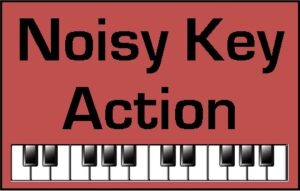 However, there are a couple downsides with this TP/400 key action. These downsides (cons) will affect some people negatively and other people will not be bothered by these issues. It just depends on where you are playing this piano (home, studio, church, school, stage, etc) and your experience in playing other pianos.
However, there are a couple downsides with this TP/400 key action. These downsides (cons) will affect some people negatively and other people will not be bothered by these issues. It just depends on where you are playing this piano (home, studio, church, school, stage, etc) and your experience in playing other pianos.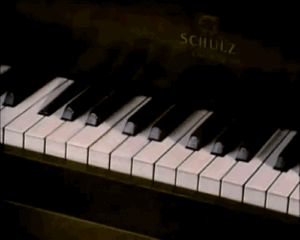 However, when the keys are coming back up to resting position on the XGT, then that part of the key movement is relatively quiet. There is still a small bit of key noise when the keys come back up, but it’s acceptable and normal and should not bother you at all. So that’s a good thing since some digital pianos have very noisy keys when the keys are coming back up.
However, when the keys are coming back up to resting position on the XGT, then that part of the key movement is relatively quiet. There is still a small bit of key noise when the keys come back up, but it’s acceptable and normal and should not bother you at all. So that’s a good thing since some digital pianos have very noisy keys when the keys are coming back up.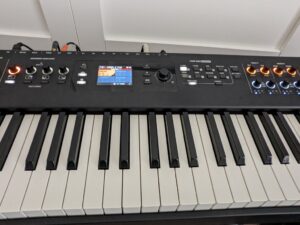 Since there seems to be a lack of padding under/over the keys, the keys/hammers hit harder when they go downward and you can physically feel that “hardness” in your fingers if you are more sensitive to that kind of thing. It can be a bit uncomfortable playing that way for some people and can be a bit fatiguing as well, depending on your fingers. But, if you are in a noisier area, playing on stage, in a noisier room or venue, and/or played piano before, then the “thumpy” key action noise and slightly “harder” key feel will likely not be an issue for you.
Since there seems to be a lack of padding under/over the keys, the keys/hammers hit harder when they go downward and you can physically feel that “hardness” in your fingers if you are more sensitive to that kind of thing. It can be a bit uncomfortable playing that way for some people and can be a bit fatiguing as well, depending on your fingers. But, if you are in a noisier area, playing on stage, in a noisier room or venue, and/or played piano before, then the “thumpy” key action noise and slightly “harder” key feel will likely not be an issue for you.KEY ACTION – CONCLUSIONS
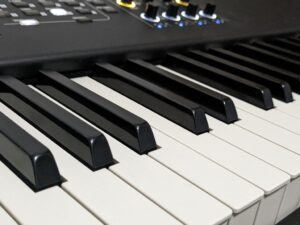 This new key action moves very well, the key-tops feel good, and the key movement is quite responsive, and I like it very much for those qualities. However, the thumping noise it makes can be disconcerting for certain people depending on your playing situation. Just so you know, you can always find “fault” with key actions for both acoustic & digital pianos because in most (but not all) cases there is no perfection. But it’s good to be aware of what’s going on, and so that’s why I try to give “full disclosure” to let you know the good & the bad. Putting aside the downsides of this key action, personally I really do like it and enjoy playing on it.
This new key action moves very well, the key-tops feel good, and the key movement is quite responsive, and I like it very much for those qualities. However, the thumping noise it makes can be disconcerting for certain people depending on your playing situation. Just so you know, you can always find “fault” with key actions for both acoustic & digital pianos because in most (but not all) cases there is no perfection. But it’s good to be aware of what’s going on, and so that’s why I try to give “full disclosure” to let you know the good & the bad. Putting aside the downsides of this key action, personally I really do like it and enjoy playing on it.PIANO SOUND
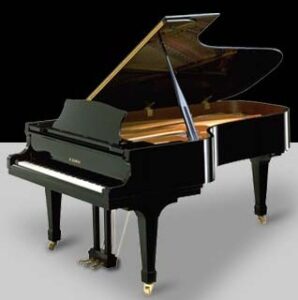 The next most important thing to me when it comes to any piano is the realism of the piano sounds. Everyone wants their digital piano to have great piano sounds, but depending on what you get, those piano sounds may not be good. So you need to be careful of what model you purchase so you can be sure those piano sounds are as realistic as possible in your price range.
The next most important thing to me when it comes to any piano is the realism of the piano sounds. Everyone wants their digital piano to have great piano sounds, but depending on what you get, those piano sounds may not be good. So you need to be careful of what model you purchase so you can be sure those piano sounds are as realistic as possible in your price range.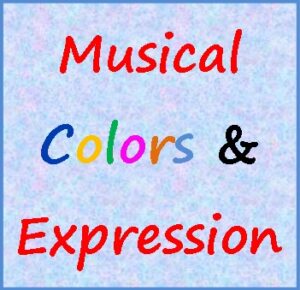 The piano sound needs to be expressive, full of musical color, changing in tone and timber depending on how hard or soft you play the keys and/or how quick or slow you move the keys. Getting the subtle nuances you would get in a real grand piano such as the overtones, vibrations, acoustic noises, cabinet vibrations, string resonances, and all the other complex organic elements that happen when playing a top acoustic grand piano is what makes a digital piano either great, average, just OK, artificial and somewhat fake, or poor and sounding like a toy.
The piano sound needs to be expressive, full of musical color, changing in tone and timber depending on how hard or soft you play the keys and/or how quick or slow you move the keys. Getting the subtle nuances you would get in a real grand piano such as the overtones, vibrations, acoustic noises, cabinet vibrations, string resonances, and all the other complex organic elements that happen when playing a top acoustic grand piano is what makes a digital piano either great, average, just OK, artificial and somewhat fake, or poor and sounding like a toy.ACOUSTIC PIANO SOUND COMPLEXITY
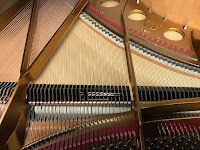 Did you know that real acoustic grand pianos have about 230 strings in them with some are combined together (2 or 3 strings) to make one note? They also have approx 70 dampers that will stop those strings (with dampers) from ringing and sustaining when the when you want that to happen? The strings are installed in specific groups with certain materials and densities for those strings. The dampers are also different in size from each other depending on the strings they cover. In other words, the piano sound in a real acoustic grand piano is very complex especially in the top name brands, both mathematically and audibly. Then of course there are 88 hammers striking those strings and those hammers need to sound percussive in nature.
Did you know that real acoustic grand pianos have about 230 strings in them with some are combined together (2 or 3 strings) to make one note? They also have approx 70 dampers that will stop those strings (with dampers) from ringing and sustaining when the when you want that to happen? The strings are installed in specific groups with certain materials and densities for those strings. The dampers are also different in size from each other depending on the strings they cover. In other words, the piano sound in a real acoustic grand piano is very complex especially in the top name brands, both mathematically and audibly. Then of course there are 88 hammers striking those strings and those hammers need to sound percussive in nature.XGT INTERNAL ACOUSTIC PIANO SOUNDS
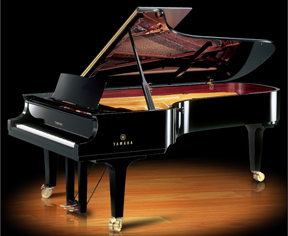 There are 4 main stereo grand piano sounds recreated from a German Steinway grand, American Steinway grand, Japanese Yamaha grand, and Italian Fazioli grand. These piano sounds are specifically referred to in the XGT as “German, Japanese, American, and Italian.” They don’t use the brand names because of copyright and brand ownership restrictions.
There are 4 main stereo grand piano sounds recreated from a German Steinway grand, American Steinway grand, Japanese Yamaha grand, and Italian Fazioli grand. These piano sounds are specifically referred to in the XGT as “German, Japanese, American, and Italian.” They don’t use the brand names because of copyright and brand ownership restrictions.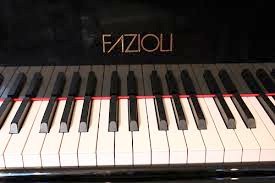 The only piano sound in that group that I thought needed some real “tweaking” was the Italian Fazioli concert grand. This is because it came out sounding much too bright and metallic, especially if you play with more finger force. But if you like a brighter and more metallic grand piano sound with a big bass sound at the same time in the lower octaves that can all really “cut through” and be heard above other players (if you are playing in a band or with other players), then the Fazioli grand sound will definitely do that for you and is impressive in that way.
The only piano sound in that group that I thought needed some real “tweaking” was the Italian Fazioli concert grand. This is because it came out sounding much too bright and metallic, especially if you play with more finger force. But if you like a brighter and more metallic grand piano sound with a big bass sound at the same time in the lower octaves that can all really “cut through” and be heard above other players (if you are playing in a band or with other players), then the Fazioli grand sound will definitely do that for you and is impressive in that way.WARM OR BRIGHT PIANO SOUNDS
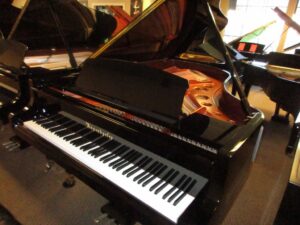 When it comes to grand piano sounds I have played just about all the great acoustic grand pianos out there for decades. I have played big Bosendorfer grands, Yamaha, Kawai, Steinway, Bechstein, Fazioli, Boston, Bluthner, and a bunch of others. So I know what they sound like and feel like to play. Different models within the same brand can play differently. So that means there is a lot of variety out there.
When it comes to grand piano sounds I have played just about all the great acoustic grand pianos out there for decades. I have played big Bosendorfer grands, Yamaha, Kawai, Steinway, Bechstein, Fazioli, Boston, Bluthner, and a bunch of others. So I know what they sound like and feel like to play. Different models within the same brand can play differently. So that means there is a lot of variety out there.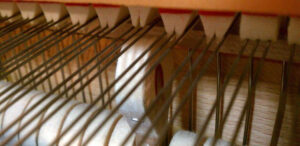 However, overall, I would consider the internal grand piano sounds in the XGT to a bit on the “bright” side and somewhat percussive. I happen to enjoy a piano sound like that so for me it’s a good thing. It’s especially true if the percussive attack part of the piano hammer sound (when the hammers strike the strings in a real piano) is realistic and organic in nature. Studiologic definitely got it right on the XGT for all 88 notes, which is not an easy thing to do.
However, overall, I would consider the internal grand piano sounds in the XGT to a bit on the “bright” side and somewhat percussive. I happen to enjoy a piano sound like that so for me it’s a good thing. It’s especially true if the percussive attack part of the piano hammer sound (when the hammers strike the strings in a real piano) is realistic and organic in nature. Studiologic definitely got it right on the XGT for all 88 notes, which is not an easy thing to do.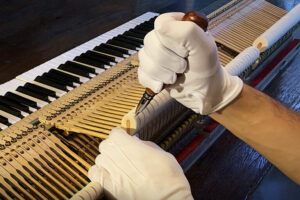 In the world of acoustic pianos, changing the piano tone can also be done and it is called “voicing the hammers.” A skilled piano technician can actually modify the hardness and or softness of each felt hammer so that when those hammers hit the strings as the piano is being played, then the piano sound will be softer/warmer or harder and brighter depending on what that technician did to those 88 felt hammers.
In the world of acoustic pianos, changing the piano tone can also be done and it is called “voicing the hammers.” A skilled piano technician can actually modify the hardness and or softness of each felt hammer so that when those hammers hit the strings as the piano is being played, then the piano sound will be softer/warmer or harder and brighter depending on what that technician did to those 88 felt hammers.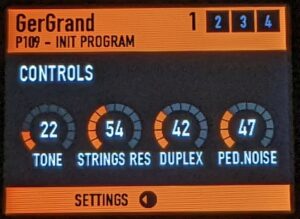 You can set up and edit different parameters in different sections of the XGT using the color display screen to see what you are doing. This custom editing will directly affect those internal grand piano sounds and make them more mellow, more resonant, in-between, and even brighter if you prefer them that way. You just need to know how to do that on the XGT and also which controls and features you need to use to make those adjustments. In other words the preset internal grand piano sounds are not set in stone.
You can set up and edit different parameters in different sections of the XGT using the color display screen to see what you are doing. This custom editing will directly affect those internal grand piano sounds and make them more mellow, more resonant, in-between, and even brighter if you prefer them that way. You just need to know how to do that on the XGT and also which controls and features you need to use to make those adjustments. In other words the preset internal grand piano sounds are not set in stone.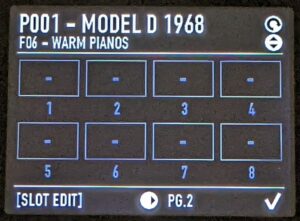 I personally made some different adjustments with the editing controls and doing that had a big effect on the outcome of the piano sounds. You may already love the piano sounds that are in the XGT. But if you want to adjust them then you can and it’s not difficult to do. You can also save your custom piano sounds to a “favorites” menu and name that menu (such as “warm pianos”) so you know what’s in there. I made changes to different piano sounds including the German and Japanese grand piano sound and it did make a big difference.
I personally made some different adjustments with the editing controls and doing that had a big effect on the outcome of the piano sounds. You may already love the piano sounds that are in the XGT. But if you want to adjust them then you can and it’s not difficult to do. You can also save your custom piano sounds to a “favorites” menu and name that menu (such as “warm pianos”) so you know what’s in there. I made changes to different piano sounds including the German and Japanese grand piano sound and it did make a big difference.ACOUSTIC PIANO “BASS STRINGS” & SOUND
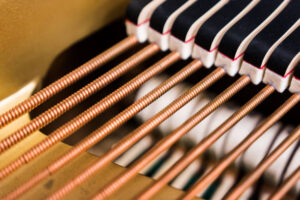 As far as bass strings go in a grand acoustic piano, the bass strings are the thickest of all the strings and they are there to give you a big, bassy sound. Did you know the dampers that are on the piano strings (for nearly all strings) are there to stop the piano sound from sustaining when you play those notes and then let go of the key? In a real grand piano, when you play the notes where the strings have dampers on them and you let go of the key right away (staccato playing), the piano sound will immediately stop on nearly all the strings, with one exception being the bass notes.
As far as bass strings go in a grand acoustic piano, the bass strings are the thickest of all the strings and they are there to give you a big, bassy sound. Did you know the dampers that are on the piano strings (for nearly all strings) are there to stop the piano sound from sustaining when you play those notes and then let go of the key? In a real grand piano, when you play the notes where the strings have dampers on them and you let go of the key right away (staccato playing), the piano sound will immediately stop on nearly all the strings, with one exception being the bass notes.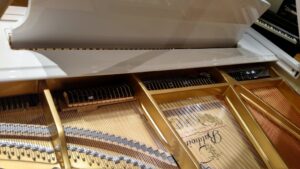 However, on almost all digital pianos, the lower bass notes immediately stop resonating and sustaining as soon as you release the key, which is how the other keys in the main octaves behave. In other words those bass notes don’t behave like they do in a real grand piano. The middle octaves and nearly all the other keys are supposed to stop making sound as soon as you let go of the keys, and that would be normal in acoustic & digital pianos. The very highest octaves in acoustic pianos don’t have dampers but the rest of the notes do have dampers. Dampers are very important or a piano could not play correctly.
However, on almost all digital pianos, the lower bass notes immediately stop resonating and sustaining as soon as you release the key, which is how the other keys in the main octaves behave. In other words those bass notes don’t behave like they do in a real grand piano. The middle octaves and nearly all the other keys are supposed to stop making sound as soon as you let go of the keys, and that would be normal in acoustic & digital pianos. The very highest octaves in acoustic pianos don’t have dampers but the rest of the notes do have dampers. Dampers are very important or a piano could not play correctly.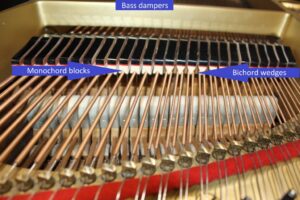 But in a real acoustic grand piano, there are physics involved and the lowest octave strings don’t stop sustaining immediately when the dampers go back down on those notes. It takes a couple seconds for them to quiet down and that’s because those strings are physically so large, especially as compared to the rest of the strings in a grand piano.
But in a real acoustic grand piano, there are physics involved and the lowest octave strings don’t stop sustaining immediately when the dampers go back down on those notes. It takes a couple seconds for them to quiet down and that’s because those strings are physically so large, especially as compared to the rest of the strings in a grand piano.SAMPLING + PHYSICAL MODELING SOUND TECHNOLOGY
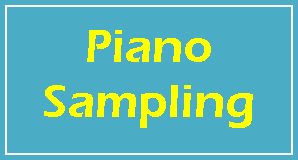 With regard to the overall piano sound in digital pianos, one of the downsides in using only “sampling” to record and produce the piano sound is the fact that the piano sound your hearing is a “sample.” This piano sample is a very short recording of the piano sound (about 2 to 3 seconds in many cases) and that sample is then electronically fastened together end-to-end and is “looped” so that it plays over and over. If the sampling process is done correctly then that piano sound can come out more normally.
With regard to the overall piano sound in digital pianos, one of the downsides in using only “sampling” to record and produce the piano sound is the fact that the piano sound your hearing is a “sample.” This piano sample is a very short recording of the piano sound (about 2 to 3 seconds in many cases) and that sample is then electronically fastened together end-to-end and is “looped” so that it plays over and over. If the sampling process is done correctly then that piano sound can come out more normally.
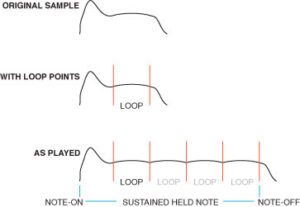 But the negative aspect of sampling is that typically you will hear the “loop point” which is the place where the sample starts and stops and then repeats itself over and over…like a hula-hoop going round and round. When you sustain that sampled piano sound then you can (in many cases depending on brand and model) hear that looping piano sound start and stop, like something is wrong with the sound.
But the negative aspect of sampling is that typically you will hear the “loop point” which is the place where the sample starts and stops and then repeats itself over and over…like a hula-hoop going round and round. When you sustain that sampled piano sound then you can (in many cases depending on brand and model) hear that looping piano sound start and stop, like something is wrong with the sound.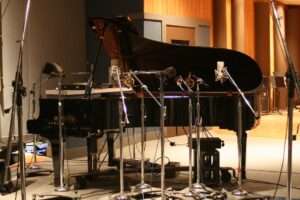 With the Studiologic XGT, they use a high end sampling process with special microphones set up in specific ways at a grand piano in a pro recording piano studio. Then they couple that recorded sound with their own proprietary physical modeling technology. Their main piano sounds do not have the obvious “sound looping” you would normally hear using just sampling technology alone. I did not hear noticeable electronic looping with their acoustic piano sounds except for one of the sounds here and there, and only while sustaining those notes for a period of time. It’s there, but you may not hear it. I talk more about sample looping for the non-piano instrument sounds further down in this review.
With the Studiologic XGT, they use a high end sampling process with special microphones set up in specific ways at a grand piano in a pro recording piano studio. Then they couple that recorded sound with their own proprietary physical modeling technology. Their main piano sounds do not have the obvious “sound looping” you would normally hear using just sampling technology alone. I did not hear noticeable electronic looping with their acoustic piano sounds except for one of the sounds here and there, and only while sustaining those notes for a period of time. It’s there, but you may not hear it. I talk more about sample looping for the non-piano instrument sounds further down in this review.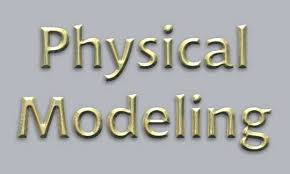 I did hear some definite string modulation and movement when sustaining those piano tones which is normal and good. However, from time to time, depending on which piano sound I was playing, I also heard a few anomalies in the piano sound, especially on the downward side of the piano decay time. These “artifacts” can and do occur on many digital pianos because they are electronic instruments after all. It’s relatively minor issue but it can show up if you play with longer sustain times.
I did hear some definite string modulation and movement when sustaining those piano tones which is normal and good. However, from time to time, depending on which piano sound I was playing, I also heard a few anomalies in the piano sound, especially on the downward side of the piano decay time. These “artifacts” can and do occur on many digital pianos because they are electronic instruments after all. It’s relatively minor issue but it can show up if you play with longer sustain times.PIANO SUSTAIN-DECAY TIME
 As far as the piano sound goes with regard to sustain decay time, this model is very good, but not perfect. Piano decay means how long it takes for the piano sound to fade out when holding down the sustain/damper pedal. The XGT has a reasonable amount of piano decay/sustain time and it really does sound fairly natural. Not only the decay time is good but also a natural volume during that decay time is fairly steady.
As far as the piano sound goes with regard to sustain decay time, this model is very good, but not perfect. Piano decay means how long it takes for the piano sound to fade out when holding down the sustain/damper pedal. The XGT has a reasonable amount of piano decay/sustain time and it really does sound fairly natural. Not only the decay time is good but also a natural volume during that decay time is fairly steady.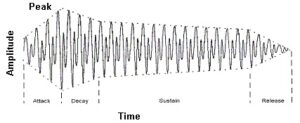 Basically, there is a lot going on sonically when it comes to a real grand piano sound sustaining/decaying over time when holding down the damper pedal. There’s all kinds of overtones and sympathetic vibrations along with organic tonal elements due to the physical nature of a wooden acoustic grand piano. With all of this to consider, I give the XGT a definite passing grade for its ability to recreate convincing acoustic grand piano sounds and piano sustain, given the fact that it is an electronic instrument and not acoustic.
Basically, there is a lot going on sonically when it comes to a real grand piano sound sustaining/decaying over time when holding down the damper pedal. There’s all kinds of overtones and sympathetic vibrations along with organic tonal elements due to the physical nature of a wooden acoustic grand piano. With all of this to consider, I give the XGT a definite passing grade for its ability to recreate convincing acoustic grand piano sounds and piano sustain, given the fact that it is an electronic instrument and not acoustic.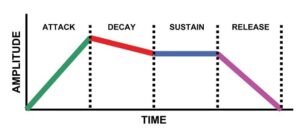 But…real acoustic grand pianos have much longer and much bigger piano sustain and piano sustain/decay times and the XGT doesn’t come close to that. So if you are wanting to get this model to mainly play big classical piano music on it and are expecting musical perfection when it comes to the acoustic piano sounds, then you could be disappointed. But it is only $2199 after-all and perfection should not be expected in this price range. Nevertheless, as far as I am concerned the grand piano sounds are very impressive.
But…real acoustic grand pianos have much longer and much bigger piano sustain and piano sustain/decay times and the XGT doesn’t come close to that. So if you are wanting to get this model to mainly play big classical piano music on it and are expecting musical perfection when it comes to the acoustic piano sounds, then you could be disappointed. But it is only $2199 after-all and perfection should not be expected in this price range. Nevertheless, as far as I am concerned the grand piano sounds are very impressive.PIANO SOUND – CONCLUSIONS
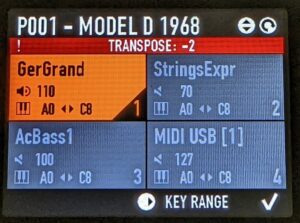 Whether you are playing the acoustic piano sounds softly, quickly, hard and aggressively with different note velocities, with fast repetition, delicately, using the damper pedal, playing multiple notes and chords and having the notes mix altogether, in my opinion the XGT is a winner despite a few of its shortcomings.
Whether you are playing the acoustic piano sounds softly, quickly, hard and aggressively with different note velocities, with fast repetition, delicately, using the damper pedal, playing multiple notes and chords and having the notes mix altogether, in my opinion the XGT is a winner despite a few of its shortcomings. 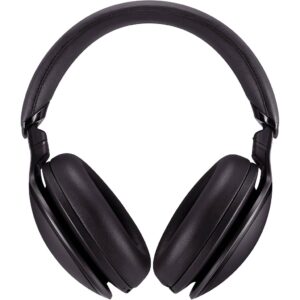 Speaking of headphones, the grand piano sounds (as well as the instrumental sounds) really sounded great through my stereo studio headphones. Sometimes the sound from a few of these digital pianos through headphones is just mediocre at best. But in this model the sound through a good pair of headphones was very “alive” and well balanced from the bass octaves through treble octaves, so I was impressed with that especially since I do use headphones quite a bit.
Speaking of headphones, the grand piano sounds (as well as the instrumental sounds) really sounded great through my stereo studio headphones. Sometimes the sound from a few of these digital pianos through headphones is just mediocre at best. But in this model the sound through a good pair of headphones was very “alive” and well balanced from the bass octaves through treble octaves, so I was impressed with that especially since I do use headphones quite a bit.POLYPHONY
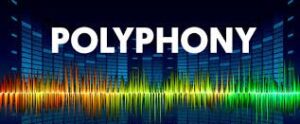 The word “polyphony” means how how many notes can be played on the keyboard without dropping out. Polyphony is the piano and instrument processing power, and depending on how much total polyphony a particular model has, the end result is that your music might be affected if the instrument does not have enough polyphony for your needs.
The word “polyphony” means how how many notes can be played on the keyboard without dropping out. Polyphony is the piano and instrument processing power, and depending on how much total polyphony a particular model has, the end result is that your music might be affected if the instrument does not have enough polyphony for your needs.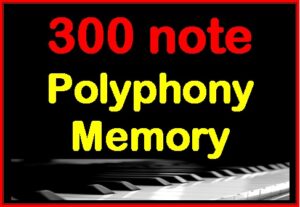 The XGT is 300 note polyphony (maximum) which sounds like a lot, and it is. So that’s a good thing. The word “maximum” means the total amount of polyphony at any one time in mono. With the XGT having many stereo piano and instrumental sounds, 300 divided by 2 is 150. So there would be 150 notes of polyphony if you are playing a stereo grand piano sound.
The XGT is 300 note polyphony (maximum) which sounds like a lot, and it is. So that’s a good thing. The word “maximum” means the total amount of polyphony at any one time in mono. With the XGT having many stereo piano and instrumental sounds, 300 divided by 2 is 150. So there would be 150 notes of polyphony if you are playing a stereo grand piano sound.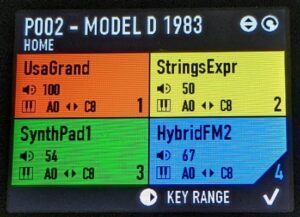 In other words, when you play 4 sounds together like you can on the XGT, and some or all of them are in stereo, the nearly all of the polyphony might be used up especially if you are playing a lot of notes at the same time and also using your sustain pedal. So on the XGT, being a stage piano that can have a lot of sounds and effects all going at the same time, you need to have a lot of polyphony processing power so that you do not have noticeable “note drop-out.”
In other words, when you play 4 sounds together like you can on the XGT, and some or all of them are in stereo, the nearly all of the polyphony might be used up especially if you are playing a lot of notes at the same time and also using your sustain pedal. So on the XGT, being a stage piano that can have a lot of sounds and effects all going at the same time, you need to have a lot of polyphony processing power so that you do not have noticeable “note drop-out.” When it comes to the polyphony specification, 300 notes of maximum polyphony is more than the majority of what digital pianos have these days. The higher quality of the internal instrument sounds in the XGT are overall able to handle the 300 note maximum polyphony in a good way without issues. Having enough polyphony in a digital piano is very important to me because I tend to “max out” the piano with mixing as many stereo instrument sounds as possible along with using a good amount of sustain with my sustain pedals. I don’t want “note drop-out” if I can avoid it and I would definitely give this model a passing grade when it comes to its polyphony technology and ability to cover up to 4 instrument sounds at one time.
When it comes to the polyphony specification, 300 notes of maximum polyphony is more than the majority of what digital pianos have these days. The higher quality of the internal instrument sounds in the XGT are overall able to handle the 300 note maximum polyphony in a good way without issues. Having enough polyphony in a digital piano is very important to me because I tend to “max out” the piano with mixing as many stereo instrument sounds as possible along with using a good amount of sustain with my sustain pedals. I don’t want “note drop-out” if I can avoid it and I would definitely give this model a passing grade when it comes to its polyphony technology and ability to cover up to 4 instrument sounds at one time.PEDALS
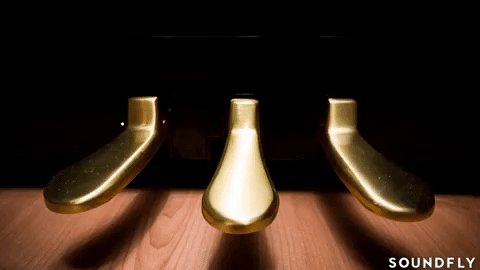 Most people who play piano know how important the pedals are in helping to produce realistic piano sound. If the pedals are not working correctly and doing what pedals are supposed to do, and the piano sound is not reacting naturally when using those pedals, then that’s a big problem for me. This is especially true of the damper/sustain pedal.
Most people who play piano know how important the pedals are in helping to produce realistic piano sound. If the pedals are not working correctly and doing what pedals are supposed to do, and the piano sound is not reacting naturally when using those pedals, then that’s a big problem for me. This is especially true of the damper/sustain pedal.PORTABLE TRIPLE PEDAL UNIT
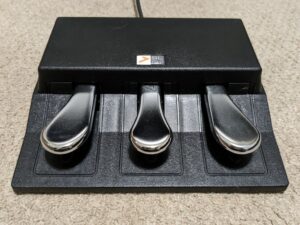 The XGT comes with a triple pedal unit. Many stage pianos only come with a single pedal and sometimes that pedal does not have half-damper ability. Some stage piano companies don’t have an option for a triple pedal unit or don’t come with a triple pedal. So to get a triple pedal unit with this piano that can be programmed and have lots of good control over the instrument sounds is is very good to have. The half-damper sustain pedal control gives you a variable amount of sustain instead of just off & on sustain. If you are a piano player then you will appreciate this feature with the sustain pedal
The XGT comes with a triple pedal unit. Many stage pianos only come with a single pedal and sometimes that pedal does not have half-damper ability. Some stage piano companies don’t have an option for a triple pedal unit or don’t come with a triple pedal. So to get a triple pedal unit with this piano that can be programmed and have lots of good control over the instrument sounds is is very good to have. The half-damper sustain pedal control gives you a variable amount of sustain instead of just off & on sustain. If you are a piano player then you will appreciate this feature with the sustain pedal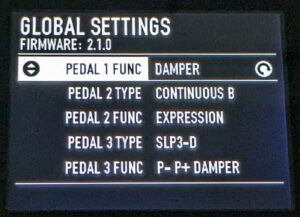 Also, the triple pedal unit can be programmed to do other functions. This would include selecting pre-saved instrument registrations/programs and move them up or down in a particular order while you are playing so that you can remotely select new sound setups for the keyboard with your foot without taking your fingers off the keys to do that. You can also plug in two separate single pedals and program those pedals to activate pedal functions in the piano such as expression pedal, separate continuous controllers, and so on.
Also, the triple pedal unit can be programmed to do other functions. This would include selecting pre-saved instrument registrations/programs and move them up or down in a particular order while you are playing so that you can remotely select new sound setups for the keyboard with your foot without taking your fingers off the keys to do that. You can also plug in two separate single pedals and program those pedals to activate pedal functions in the piano such as expression pedal, separate continuous controllers, and so on.VINTAGE ELECTRIC PIANO SUSTAIN TIME
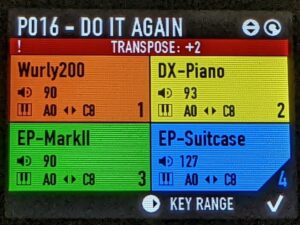 When it comes to the vintage electric piano sounds in this model, there are a lot of them and they are very good. The sustain time and sustain quality when using the sustain pedal is equally important for the electric piano sounds. I found the quality and length of sustain time for those vintage electric piano sounds to be quite impressive . This helped to recreate the older vintage piano sounds (along with Studiologic DSP effects) that people like and can be very enjoyable to play depending on where you are playing and the type of music you want to do.
When it comes to the vintage electric piano sounds in this model, there are a lot of them and they are very good. The sustain time and sustain quality when using the sustain pedal is equally important for the electric piano sounds. I found the quality and length of sustain time for those vintage electric piano sounds to be quite impressive . This helped to recreate the older vintage piano sounds (along with Studiologic DSP effects) that people like and can be very enjoyable to play depending on where you are playing and the type of music you want to do.CONTINUOUS PEDAL SUSTAIN
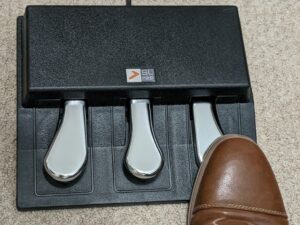 What I mean by “continuous pedal sustain” (aka: pedal hold) is that it allows the non-piano instrument sounds like strings, horns, synths, organs, etc, to have continuous sustain without any decay as long as you hold down the sustain pedal. In other words, instead of that sound being percussive (staccato) and immediately stopping when you release a key after pressing it down, these various instrument sounds can continue to sustain and hold as long as you hold down the sustain pedal. It would be like a trumpet or violin to be heard continuously as long as you keep that sustain pedal down. This feature can add another dimension to your music and is very useful. Other brands such as Yamaha cannot do this.
What I mean by “continuous pedal sustain” (aka: pedal hold) is that it allows the non-piano instrument sounds like strings, horns, synths, organs, etc, to have continuous sustain without any decay as long as you hold down the sustain pedal. In other words, instead of that sound being percussive (staccato) and immediately stopping when you release a key after pressing it down, these various instrument sounds can continue to sustain and hold as long as you hold down the sustain pedal. It would be like a trumpet or violin to be heard continuously as long as you keep that sustain pedal down. This feature can add another dimension to your music and is very useful. Other brands such as Yamaha cannot do this.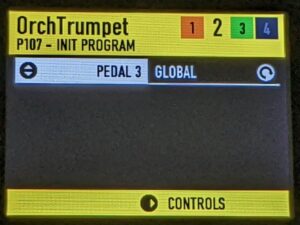 Those instrumental sounds can also be held and sustained just by holding down a key (which is good). But having the sustain pedal do it gives you pedal control over all sounds in the mix and each instrument sound can be adjusted to have the continuous sustain or not have it depending on what you need.
Those instrumental sounds can also be held and sustained just by holding down a key (which is good). But having the sustain pedal do it gives you pedal control over all sounds in the mix and each instrument sound can be adjusted to have the continuous sustain or not have it depending on what you need.NATURAL DAMPER PEDAL NOISE REPRODUCTION
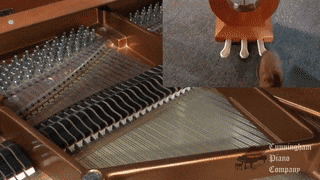
Another really cool aspect to using pedals on the XGT is the organic nature of the damper-sustain pedal. In a real acoustic grand piano when you press down the damper-sustain pedal, that pedal pushes the physical dampers off the strings of a real piano by lifting up the damper rail which takes the dampers off the strings so they can all sustain. When those dampers lift off the strings then you can hear an echo noise of all those strings starting to resonate. When the damper-sustain pedal is released then the damper rail with their felt dampers comes back down onto the strings to stop the strings from resonating in a real grand piano.
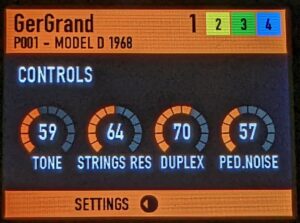 When that damper rail comes back down it creates some “pedal noise” like a small little mechanical “clunk.” You can hear and feel this sensation in a real grand piano, and those people, like myself, who have played grand pianos for a while know what I am talking about. The XGT can recreate these resonations and damper rail noises perfectly when using the triple pedal sustain pedal. There is a digital feature called “pedal noise” which is programmed into the piano sustain control for the XGT.
When that damper rail comes back down it creates some “pedal noise” like a small little mechanical “clunk.” You can hear and feel this sensation in a real grand piano, and those people, like myself, who have played grand pianos for a while know what I am talking about. The XGT can recreate these resonations and damper rail noises perfectly when using the triple pedal sustain pedal. There is a digital feature called “pedal noise” which is programmed into the piano sustain control for the XGT.INSTRUMENTAL SOUNDS
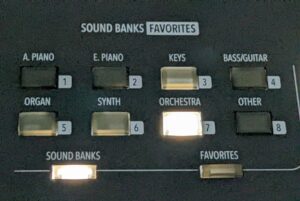 In the XGT there are 218 individual instrument sounds divided up into 8 groups which include all of the piano sounds. There are also 2 different drum kits on board with many individual percussive sounds per kit. As with many digital pianos with instrument sounds, many are excellent, some very good, and a few are OK. There are pianos, electric pianos, strings, synths, orchestral, organs, brass, guitars, and just about anything else you could want.
In the XGT there are 218 individual instrument sounds divided up into 8 groups which include all of the piano sounds. There are also 2 different drum kits on board with many individual percussive sounds per kit. As with many digital pianos with instrument sounds, many are excellent, some very good, and a few are OK. There are pianos, electric pianos, strings, synths, orchestral, organs, brass, guitars, and just about anything else you could want.
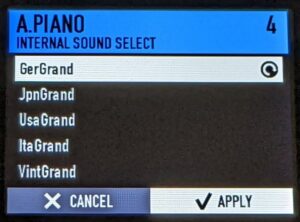 In my opinion and based on years of playing experience, it’s not how many sounds you have in your digital piano or keyboard that count, but it’s the realism and authenticity of those sounds that matter. I’d rather have a couple hundred awesome sounds then 1000 mediocre sounds when it comes to playing music.
In my opinion and based on years of playing experience, it’s not how many sounds you have in your digital piano or keyboard that count, but it’s the realism and authenticity of those sounds that matter. I’d rather have a couple hundred awesome sounds then 1000 mediocre sounds when it comes to playing music.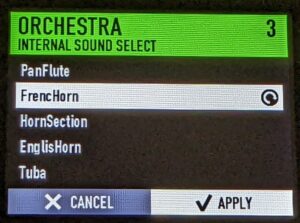 Not only are many of the acoustic grand piano tones impressive as I previously mentioned, but many of of the strings, organs, and orchestral sounds are really outstanding. You can put together an entire concert of organs, orchestral sounds including various brass and woodwinds, mix them together (as I discuss below) and be able to create some very inspiring and realistic musical orchestral scores in real-time in ways that most other digital pianos cannot do. Definitely a more natural, organic musical experience with these instrumental sounds on the XGT.
Not only are many of the acoustic grand piano tones impressive as I previously mentioned, but many of of the strings, organs, and orchestral sounds are really outstanding. You can put together an entire concert of organs, orchestral sounds including various brass and woodwinds, mix them together (as I discuss below) and be able to create some very inspiring and realistic musical orchestral scores in real-time in ways that most other digital pianos cannot do. Definitely a more natural, organic musical experience with these instrumental sounds on the XGT.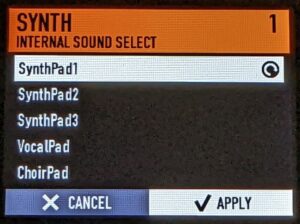 One of the other nice things about these instrument sounds is that you can use the special effects section of the XGT to enhance those instrument sounds and make them even more realistic. The special effects section is important to these sounds and they really can make a huge difference in the outcome in terms of realism and enjoyment. You can do many things which include adding an adjustable stereo spread to the sound, reverb variations, and a variety of other effects depending on what you need. It just depends on which instruments you are using from the sound library categories and the effects will enhance them. I will talk about the special effects section further down in this review.
One of the other nice things about these instrument sounds is that you can use the special effects section of the XGT to enhance those instrument sounds and make them even more realistic. The special effects section is important to these sounds and they really can make a huge difference in the outcome in terms of realism and enjoyment. You can do many things which include adding an adjustable stereo spread to the sound, reverb variations, and a variety of other effects depending on what you need. It just depends on which instruments you are using from the sound library categories and the effects will enhance them. I will talk about the special effects section further down in this review.SAMPLE LOOPING
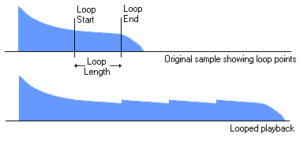 One thing I did notice with a some of the instrument sounds in the XGT is many of the instrumental sounds had some noticeable “looping” going on when you sustained some of those instruments sounds such as brass, some orchestral, some guitars, some synths, etc. These sounds are “sampled” and one of the well known downsides to “sampling” is the fact that samples are actually just very short recordings of the actual instrument sounds with the recordings being a couple seconds long of so and then that short recording is tied or “looped” together to form a continuous sound.
One thing I did notice with a some of the instrument sounds in the XGT is many of the instrumental sounds had some noticeable “looping” going on when you sustained some of those instruments sounds such as brass, some orchestral, some guitars, some synths, etc. These sounds are “sampled” and one of the well known downsides to “sampling” is the fact that samples are actually just very short recordings of the actual instrument sounds with the recordings being a couple seconds long of so and then that short recording is tied or “looped” together to form a continuous sound.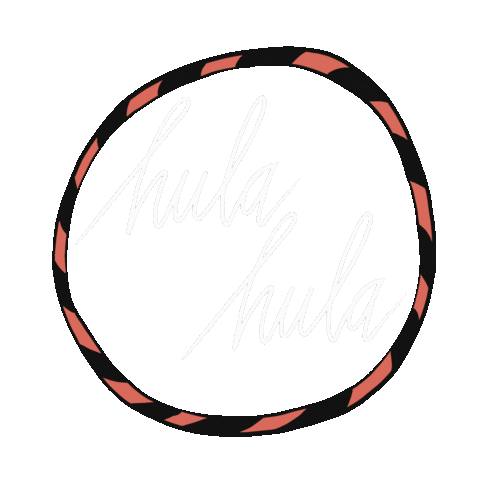 If you hold out that sampled sound on the XGT or almost any digital piano by pressing down a key and holding it, that’s when you can hear the loop beginning and end point, and that looping continues on until you let go of the key. This noticeable looping only really shows up when you hold out an instrument sound like trumpet, violin, etc for multiple seconds. If you let go of that sound somewhat quickly with your finger or your sustain pedal, then you don’t hear the “looped” portion of the sound.
If you hold out that sampled sound on the XGT or almost any digital piano by pressing down a key and holding it, that’s when you can hear the loop beginning and end point, and that looping continues on until you let go of the key. This noticeable looping only really shows up when you hold out an instrument sound like trumpet, violin, etc for multiple seconds. If you let go of that sound somewhat quickly with your finger or your sustain pedal, then you don’t hear the “looped” portion of the sound.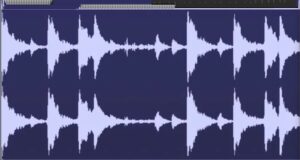 But…in most cases you would not necessarily be sustaining those sounds long enough to hear the looping or you might have that sound combined in a layer with other sounds and most people would likely not notice it that way. But if you do sustain that sampled instrument tone and you are listening to it and sustaining it by itself and not layered with other tones, then you will notice it if you listen for it.
But…in most cases you would not necessarily be sustaining those sounds long enough to hear the looping or you might have that sound combined in a layer with other sounds and most people would likely not notice it that way. But if you do sustain that sampled instrument tone and you are listening to it and sustaining it by itself and not layered with other tones, then you will notice it if you listen for it.INSTRUMENT PROGRAMS
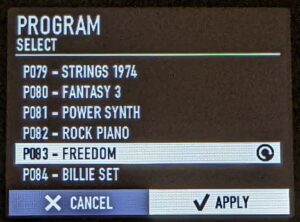 The XGT has a feature called “Programs.” You can insert and save up to 4 instruments of your choice in a “program” out of the 218 internal instruments. You can put them in any order and in any configuration in any of the 250 program spaces available in the XGT. You can quickly access any of the 250 programs by a single knob and once you locate the program you want then you can simply play and get the sound setup in that program. You can play the various instrument sounds in each program by themselves or in combination with each other or split them up among themselves, or a mix of that.
The XGT has a feature called “Programs.” You can insert and save up to 4 instruments of your choice in a “program” out of the 218 internal instruments. You can put them in any order and in any configuration in any of the 250 program spaces available in the XGT. You can quickly access any of the 250 programs by a single knob and once you locate the program you want then you can simply play and get the sound setup in that program. You can play the various instrument sounds in each program by themselves or in combination with each other or split them up among themselves, or a mix of that.
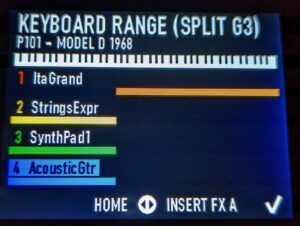 The XGT is capable of mixing/layering up to 4 separate instrument sounds together or assigning up to 4 instrument sounds to be split into different “zones” on the keyboard. You can have each sound on different sections of the keyboard as well as mix them together and put each sound in those sections in any octave that you need. So the XGT is very versatile in that way.
The XGT is capable of mixing/layering up to 4 separate instrument sounds together or assigning up to 4 instrument sounds to be split into different “zones” on the keyboard. You can have each sound on different sections of the keyboard as well as mix them together and put each sound in those sections in any octave that you need. So the XGT is very versatile in that way.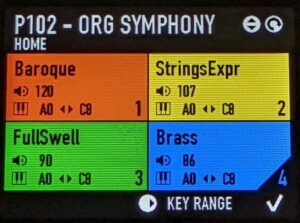 The XGT really “shines” when you do a 4 layer mix or splitting of different sounds. It’s one thing for a digital piano to be able to mix/layer together 4 sounds. But it’s another thing for those sounds to be mixed so their touch velocities compliment each other, their instrumental volumes and voicing “cut through” the mix so that you can clearly hear each one up and down the keyboard, and so that they just sound good together. That kind of thing is no easy task.
The XGT really “shines” when you do a 4 layer mix or splitting of different sounds. It’s one thing for a digital piano to be able to mix/layer together 4 sounds. But it’s another thing for those sounds to be mixed so their touch velocities compliment each other, their instrumental volumes and voicing “cut through” the mix so that you can clearly hear each one up and down the keyboard, and so that they just sound good together. That kind of thing is no easy task.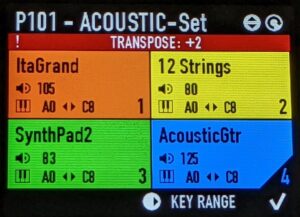 The acoustic 6-string steel string guitar is surprisingly good and even better when you use the effects section to add to the realism of that guitar through EQ, chorus, reverb, a bit of delay, etc. Then you can take that acoustic steel string and mix it with the Italian Fazioli grand piano and a touch of stereo pad along with a very nice 12-string guitar and add a stereo phaser 100 to that 12-string and you get a “mind blowing” acoustic set that is beautiful and lush..at least I thought is was.
The acoustic 6-string steel string guitar is surprisingly good and even better when you use the effects section to add to the realism of that guitar through EQ, chorus, reverb, a bit of delay, etc. Then you can take that acoustic steel string and mix it with the Italian Fazioli grand piano and a touch of stereo pad along with a very nice 12-string guitar and add a stereo phaser 100 to that 12-string and you get a “mind blowing” acoustic set that is beautiful and lush..at least I thought is was.
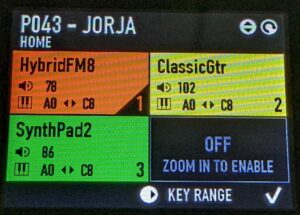 I like to do different musical things on a digital piano, particularly if it has that capability. I like to “experiment” and come up with different mixes that you may not typically hear on a digital piano but yet are things that are enjoyable to hear and can inspire you to play. Since I play guitar and have for many years along with owning some good ones, I know what guitars are supposed to sound like and I definitely am a guitar guy. But I’m also a piano guy (and organ) too since I play them professionally, and I love to play big, beautiful grand pianos.
I like to do different musical things on a digital piano, particularly if it has that capability. I like to “experiment” and come up with different mixes that you may not typically hear on a digital piano but yet are things that are enjoyable to hear and can inspire you to play. Since I play guitar and have for many years along with owning some good ones, I know what guitars are supposed to sound like and I definitely am a guitar guy. But I’m also a piano guy (and organ) too since I play them professionally, and I love to play big, beautiful grand pianos.But based on my extensive playing time with these various instrument sounds on the XGT including time playing and listening to the reproductions of Hammond B3 sounds, vintage organ sounds, pipe organs, acoustic & electric guitars, acoustic pianos, vintage electric pianos such as a variety Wurlitzer’s, Rhodes, Yamaha DX7’s, and others, I must admit they are impressive and very musical. Along with horns, a variety of strings including orchestral, chamber strings, and a variety of solo strings and all of the other instruments, I can safely say that you will be very happy with the way they sound.
ACOUSTIC REALISM OF BASS INSTRUMENTS
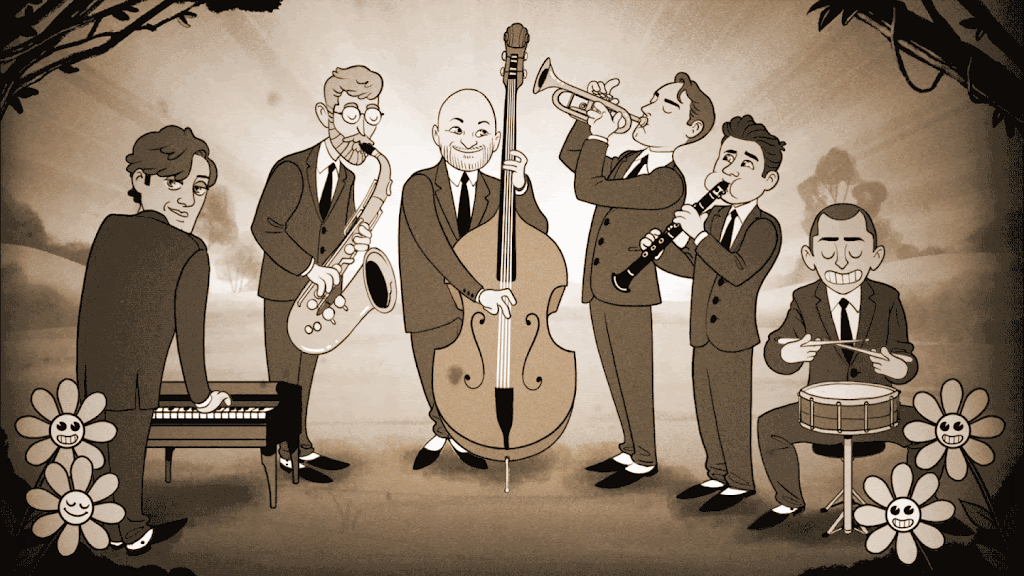 Even the upright bass sounds such as acoustic upright bass 1 is clearly more realistic than many others I have played in other brands and models of portable digital pianos. When you play a note and move down from middle C all the way into the lowest octave, you hear natural sounding organic changes in the tone of those acoustic bass sounds as you play the keys with more or less force.
Even the upright bass sounds such as acoustic upright bass 1 is clearly more realistic than many others I have played in other brands and models of portable digital pianos. When you play a note and move down from middle C all the way into the lowest octave, you hear natural sounding organic changes in the tone of those acoustic bass sounds as you play the keys with more or less force. You hear such things such as the fingers slapping the bass strings when you press the keys harder, the strings resonating in different ways depending on the notes you are striking on the keys, organic wooden sounds that you might hear coming from a large wooden acoustic bass, and even the strings themselves shaking and making acoustic string buzzing and mechanical/acoustic noises like you would get on the actual instrument.
You hear such things such as the fingers slapping the bass strings when you press the keys harder, the strings resonating in different ways depending on the notes you are striking on the keys, organic wooden sounds that you might hear coming from a large wooden acoustic bass, and even the strings themselves shaking and making acoustic string buzzing and mechanical/acoustic noises like you would get on the actual instrument. There is so much “expression” and musical color that can come out of these instrumental sounds depending in part on how soft or hard you play the keys and/or how you use your pedals. The realism of these various sounds is impressive, and when you combine them together in layers of up to 4 instruments, then your music will be even more exciting. It’s almost like you have a full orchestra or band at your fingertips and controlling each player while you play…it can sound that good. I was certainly impressed.
SMOOTH SOUND TRANSITIONS
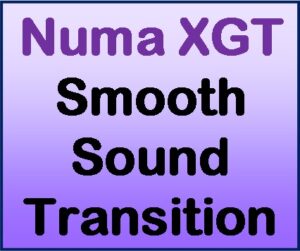 In some cases with some brands and models of digital stage pianos, you don’t always get a realistic library of non-piano instrument sounds, especially in this price range under $2000. Plus you don’t necessarily get good special effects technology & control to add to the sound realism. Plus, in this model, the XGT has what’s known as “smooth sound transition.” Some digital pianos have this feature and some don’t.
In some cases with some brands and models of digital stage pianos, you don’t always get a realistic library of non-piano instrument sounds, especially in this price range under $2000. Plus you don’t necessarily get good special effects technology & control to add to the sound realism. Plus, in this model, the XGT has what’s known as “smooth sound transition.” Some digital pianos have this feature and some don’t.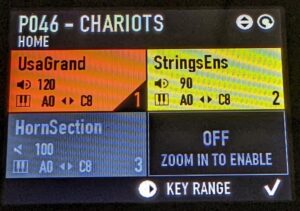 Also, when you switch from one of the sounds in a 4-layer program you have set up on the XGT and you mute any one or more the those sounds in the 4-part layer, then when you unmute those sounds or mute them, they don’t just cut off immediately. Instead of cutting off you have a smooth sound transition from one sound to the next so that there are no abnormal breaks between sounds when you are playing. It’s like one sound is fading out naturally when you move from it to another sound rather than it just immediately stop.
Also, when you switch from one of the sounds in a 4-layer program you have set up on the XGT and you mute any one or more the those sounds in the 4-part layer, then when you unmute those sounds or mute them, they don’t just cut off immediately. Instead of cutting off you have a smooth sound transition from one sound to the next so that there are no abnormal breaks between sounds when you are playing. It’s like one sound is fading out naturally when you move from it to another sound rather than it just immediately stop.INSTRUMENT SOUNDS – CONCLUSION
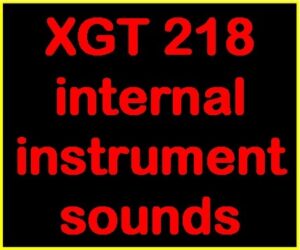 So given that Studiologic has really gone beyond the norm in creating their 218 “essential” stage piano sounds, recording studio sounds, and general instrumental sounds for the XGT that most people want and that sound really good, you should be able to find the sounds that make your music “come alive.” There are always a few sounds that any digital piano may not have such as monophonic synth (moog, etc) sounds the XGT does not have. But there are other ways the XGT can help you get those “additional sounds” which I talk about next.
So given that Studiologic has really gone beyond the norm in creating their 218 “essential” stage piano sounds, recording studio sounds, and general instrumental sounds for the XGT that most people want and that sound really good, you should be able to find the sounds that make your music “come alive.” There are always a few sounds that any digital piano may not have such as monophonic synth (moog, etc) sounds the XGT does not have. But there are other ways the XGT can help you get those “additional sounds” which I talk about next.MORE PIANO & INSTRUMENT SOUNDS
 Assuming you wanted or needed more instrument and piano sounds for the XGT than what is already in it from the factory, there are 2 additional ways to do that. The reason you may want more or different sounds depends on the style of music you’ll be playing and the actual instrument sounds that would work the best for you.
Assuming you wanted or needed more instrument and piano sounds for the XGT than what is already in it from the factory, there are 2 additional ways to do that. The reason you may want more or different sounds depends on the style of music you’ll be playing and the actual instrument sounds that would work the best for you.NUMA MANAGER
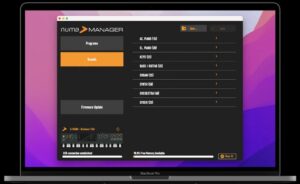 But let’s just say you needed more or different sounds because you need something specific the XGT internal sound library doesn’t have. Well, you can easily do that and one of the ways is through the Studiologic Numa external factory sound library. You can download more instruments from the Studiologic web site with an app called Numa Manager by using a mac or windows computer. So beyond the 218 internal instrument sounds in the XGT you also have the ability to get more sounds from the XGT external sound library that you can download to from computer..
But let’s just say you needed more or different sounds because you need something specific the XGT internal sound library doesn’t have. Well, you can easily do that and one of the ways is through the Studiologic Numa external factory sound library. You can download more instruments from the Studiologic web site with an app called Numa Manager by using a mac or windows computer. So beyond the 218 internal instrument sounds in the XGT you also have the ability to get more sounds from the XGT external sound library that you can download to from computer..USB AUDIO STREAMING INTERFACE
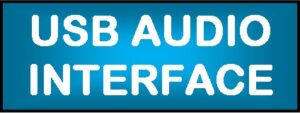 Beyond the XGT external sound library, the XGT also has a USB audio streaming interface. For me this is a bit more practical and a much quicker method of getting more instrument sounds along with more effects, drum rhythm patterns, accompaniment style patterns for a one-man-band setup, and also piano educational software apps should you want to improve your playing skills or teach someone else to play piano and keyboard.
Beyond the XGT external sound library, the XGT also has a USB audio streaming interface. For me this is a bit more practical and a much quicker method of getting more instrument sounds along with more effects, drum rhythm patterns, accompaniment style patterns for a one-man-band setup, and also piano educational software apps should you want to improve your playing skills or teach someone else to play piano and keyboard.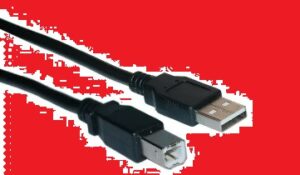 Some good examples of using USB audio streaming on the XGT is to first connect an external device like an iPad to the XGT. You would do this by getting the correct USB cable along with the iPad camera connector (a special cable attachment) and then plug in that cable to the XGT going out to the iPad. Once you are done with that then you are officially connected.
Some good examples of using USB audio streaming on the XGT is to first connect an external device like an iPad to the XGT. You would do this by getting the correct USB cable along with the iPad camera connector (a special cable attachment) and then plug in that cable to the XGT going out to the iPad. Once you are done with that then you are officially connected.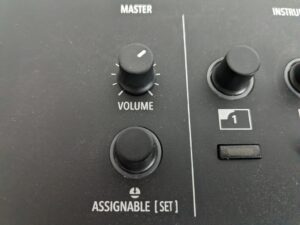 From there you have a special control knob called “assignable set” located under the master volume control and that knob can be assigned to USB audio or general audio input volume for any device that you’ve connected coming into the XGT. In this case you would assign that controller knob to USB audio. Once you do that then you press down on that knob and you can turn the USB audio streaming on or off whenever you want and also quickly control the volume of your USB device with that same knob.
From there you have a special control knob called “assignable set” located under the master volume control and that knob can be assigned to USB audio or general audio input volume for any device that you’ve connected coming into the XGT. In this case you would assign that controller knob to USB audio. Once you do that then you press down on that knob and you can turn the USB audio streaming on or off whenever you want and also quickly control the volume of your USB device with that same knob.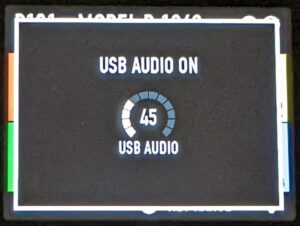 The idea of USB audio is that when you connect to an external device like an iPad for your MIDI connection, not only are you connecting through USB MIDI going out of the XGT, but you are simultaneously getting audio from the iPad coming into the XGT. This means that whatever audio sound you are hearing in the iPad (external device), it will simultaneously come into the XGT and mix with any internal instrument sounds in the XGT or be heard independently from those sounds.
The idea of USB audio is that when you connect to an external device like an iPad for your MIDI connection, not only are you connecting through USB MIDI going out of the XGT, but you are simultaneously getting audio from the iPad coming into the XGT. This means that whatever audio sound you are hearing in the iPad (external device), it will simultaneously come into the XGT and mix with any internal instrument sounds in the XGT or be heard independently from those sounds.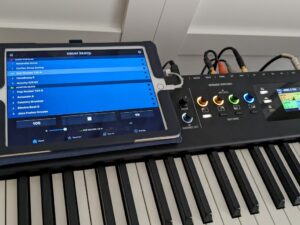 As an example, the XGT does not have any drum tracks and I like to play along with drum tracks (patterns) if I am playing music in my studio, on a solo gig, or just at home in a recreational way. So I can get a drum pattern app from the app store (there are different drum track apps) and then I can select a drum style and tempo, and that drummer is heard through the XGT speakers or through headphones via USB audio streaming and I can play along. I can independently control that external drum volume by the USB volume knob on the XGT.
As an example, the XGT does not have any drum tracks and I like to play along with drum tracks (patterns) if I am playing music in my studio, on a solo gig, or just at home in a recreational way. So I can get a drum pattern app from the app store (there are different drum track apps) and then I can select a drum style and tempo, and that drummer is heard through the XGT speakers or through headphones via USB audio streaming and I can play along. I can independently control that external drum volume by the USB volume knob on the XGT.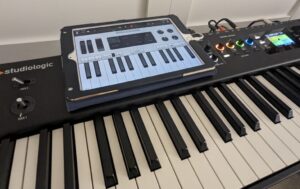 Another practical way of using USB audio is by getting instrument sounds from apps on an iPad, computer, (or iPhone) to control from the XGT such as cool synth and/or special effect sounds, more organs, electric pianos, strings, etc. A couple of examples of those kinds of apps might be Garage Band and/or Sample Tank, just to name a couple. There are many more apps (some have a cost, but they are reasonable) including acoustic piano apps such as Ravenscroft grand pianos, ivory, etc.
Another practical way of using USB audio is by getting instrument sounds from apps on an iPad, computer, (or iPhone) to control from the XGT such as cool synth and/or special effect sounds, more organs, electric pianos, strings, etc. A couple of examples of those kinds of apps might be Garage Band and/or Sample Tank, just to name a couple. There are many more apps (some have a cost, but they are reasonable) including acoustic piano apps such as Ravenscroft grand pianos, ivory, etc.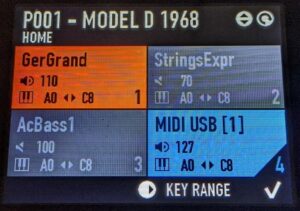 So you select the program or app you want on your computer, iPad, or iPhone as an example, and then select the USB audio from the XGT and the adjust the volume you want to have from the XGT USB volume knob, which is super convenient and practical, and then you are ready. But first you must assign the iPad to at least one quadrant of the XGT user interface screen that would say MIDI USB. That’s easy to do and once it is done then you can also use all the XGT special effects and editing features on the USB sounds as well. So there is a lot of flexibility with this feature and it works well.
So you select the program or app you want on your computer, iPad, or iPhone as an example, and then select the USB audio from the XGT and the adjust the volume you want to have from the XGT USB volume knob, which is super convenient and practical, and then you are ready. But first you must assign the iPad to at least one quadrant of the XGT user interface screen that would say MIDI USB. That’s easy to do and once it is done then you can also use all the XGT special effects and editing features on the USB sounds as well. So there is a lot of flexibility with this feature and it works well.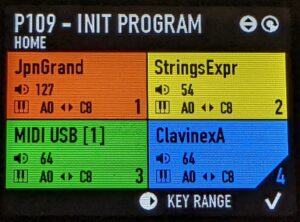 You can mix and layer the incoming USB instrument sounds from your external device (iPad, etc) with the internal sounds of the XGT in any configuration or split up to 4 sounds including the external sound into 4 keyboard zones for a split configuration. The possibilities are really endless and then you have the best of both worlds…internal and external sounds and it’s very easy to use them which is the key to success when wanting to use and change sounds quickly while you are playing, or just setting them up correctly.
You can mix and layer the incoming USB instrument sounds from your external device (iPad, etc) with the internal sounds of the XGT in any configuration or split up to 4 sounds including the external sound into 4 keyboard zones for a split configuration. The possibilities are really endless and then you have the best of both worlds…internal and external sounds and it’s very easy to use them which is the key to success when wanting to use and change sounds quickly while you are playing, or just setting them up correctly.MAIN USER INTERFACE CONTROLS
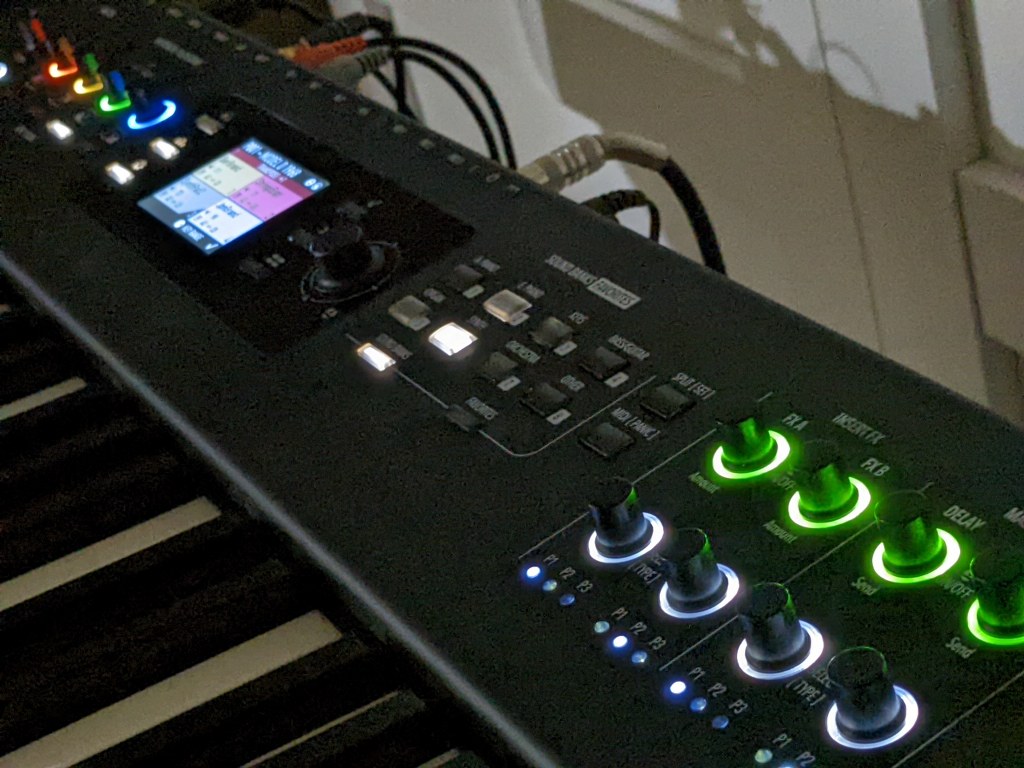
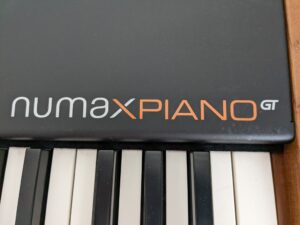
FIRST IMPRESSIONS – INTERFACE CONTROLS
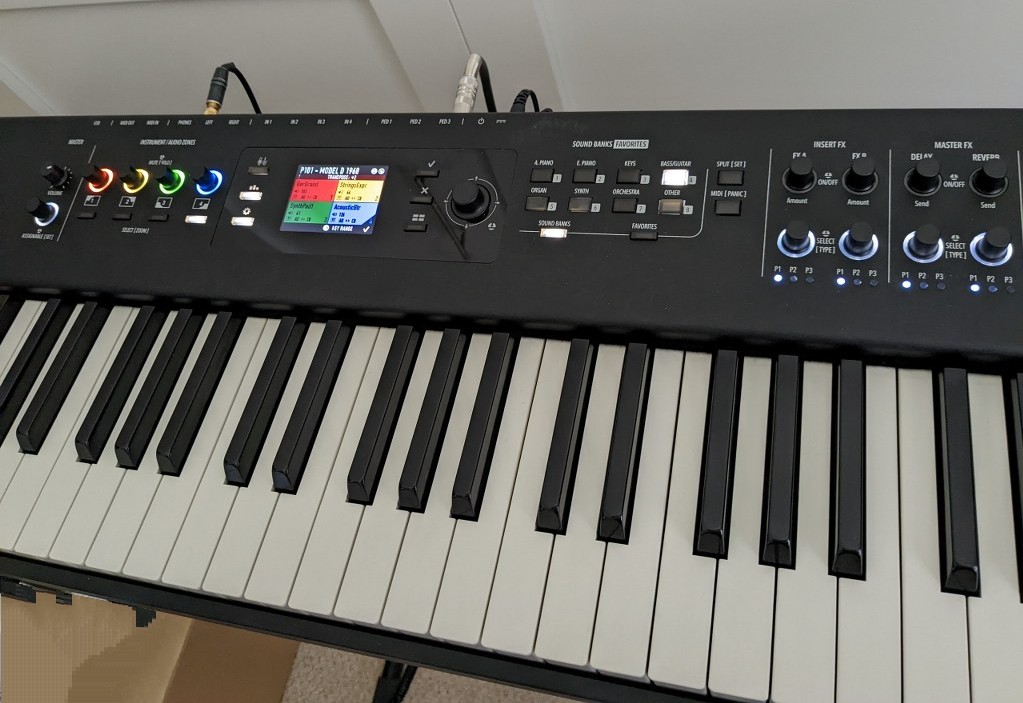
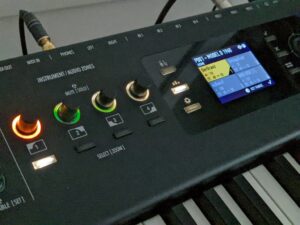 With all that in mind I give this XGT user interface a grade of an A for its ease of use both during the day and at night when it is dark. I rarely give that high of a grade to a digital piano company concerning their user interface control panel. On most top brands their control panels have some good things that make using them easy and effective.
With all that in mind I give this XGT user interface a grade of an A for its ease of use both during the day and at night when it is dark. I rarely give that high of a grade to a digital piano company concerning their user interface control panel. On most top brands their control panels have some good things that make using them easy and effective.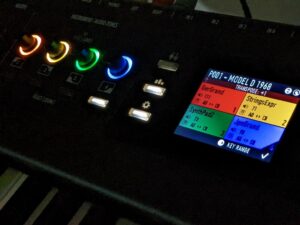 In my opinion this is not the case with the XGT user interface. Its relatively easy to figure out and even a child could probably use it effectively after playing around with it. The XGT user controls are not “childish,” but they are so easy to use (as compared to many of the other models out there) that someone young with little or no experience on this model could access and use the many functions very quickly with little effort. This is what you want out of a pro or home studio digital piano controller…quick and effective access to the sounds, effects and editing functions that are important to you.
In my opinion this is not the case with the XGT user interface. Its relatively easy to figure out and even a child could probably use it effectively after playing around with it. The XGT user controls are not “childish,” but they are so easy to use (as compared to many of the other models out there) that someone young with little or no experience on this model could access and use the many functions very quickly with little effort. This is what you want out of a pro or home studio digital piano controller…quick and effective access to the sounds, effects and editing functions that are important to you.USER INTERFACE COLOR CODE OPERATION
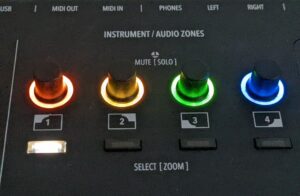 The way the user interface works is there is a 2.8″ color display screen in the center of the control panel that is divided into 4 virtual rectangular quadrants. Each quadrant is color coded with a different lighted screen color. Each quadrant in the screen is assigned a number, 1-4..There are 4 sturdy controller (encoder) knobs just to the left of the color display screen and those knobs are all in a horizontal row. Each knob is assigned to an individual quadrant, and believe it or not, those knobs have light up color coded rings at the bottom of the knobs so that the knob colors correspond to the quadrant colors in the display screen.
The way the user interface works is there is a 2.8″ color display screen in the center of the control panel that is divided into 4 virtual rectangular quadrants. Each quadrant is color coded with a different lighted screen color. Each quadrant in the screen is assigned a number, 1-4..There are 4 sturdy controller (encoder) knobs just to the left of the color display screen and those knobs are all in a horizontal row. Each knob is assigned to an individual quadrant, and believe it or not, those knobs have light up color coded rings at the bottom of the knobs so that the knob colors correspond to the quadrant colors in the display screen.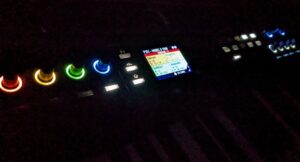 In other words, everything is color coded so that you know which sounds you are controlling and you can make changes to your sound setups easily when you look at the corresponding colors on the knobs and in the display screen. As an example, you can assign up to 4 instrument sounds in the display screen at one time. Each quadrant (or zone) can have 1 instrument sound in it, although a few of the sounds have other instrument sounds joined to them in the one sound, You can use/play each sound individually or combine any two or three of them together in a layer, or you can use/play all 4 of those sounds at one time.
In other words, everything is color coded so that you know which sounds you are controlling and you can make changes to your sound setups easily when you look at the corresponding colors on the knobs and in the display screen. As an example, you can assign up to 4 instrument sounds in the display screen at one time. Each quadrant (or zone) can have 1 instrument sound in it, although a few of the sounds have other instrument sounds joined to them in the one sound, You can use/play each sound individually or combine any two or three of them together in a layer, or you can use/play all 4 of those sounds at one time.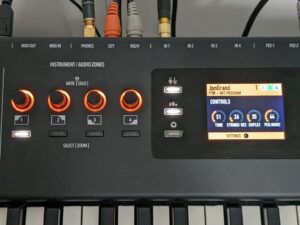 When you assign up to 4 sounds in that mode, it is called a “program.” I mentioned the “program” feature earlier. You can save up to 4 sounds of your choice as a program and then use that program to play those sounds together or apart whenever you want to. Each one of those sounds in that program can be controlled and edited individually to change individual volumes along with a very big number of editable parameters for each of those 4 instrument sounds in that program.
When you assign up to 4 sounds in that mode, it is called a “program.” I mentioned the “program” feature earlier. You can save up to 4 sounds of your choice as a program and then use that program to play those sounds together or apart whenever you want to. Each one of those sounds in that program can be controlled and edited individually to change individual volumes along with a very big number of editable parameters for each of those 4 instrument sounds in that program.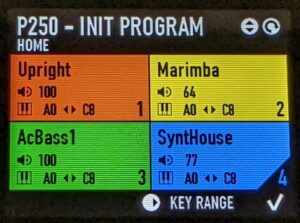 As I mentioned earlier, there are up 250 user programs available in the XGT with the first 100 of them already programmed by Studiologic with sounds in each of them. You cam change the instruments and setups in those first 100 programs to your own custom settings if you wish. With 250 programs you have plenty of options for playing live, being in a recording studio, or at home for recreational playing. Having 250 programs is a lot and you’ll be able to make any type of sound setups you can think of.
As I mentioned earlier, there are up 250 user programs available in the XGT with the first 100 of them already programmed by Studiologic with sounds in each of them. You cam change the instruments and setups in those first 100 programs to your own custom settings if you wish. With 250 programs you have plenty of options for playing live, being in a recording studio, or at home for recreational playing. Having 250 programs is a lot and you’ll be able to make any type of sound setups you can think of.CUSTOM PIANO PROGRAMS
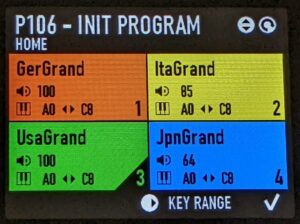 Here’s an example of a custom “user” sound setup that might be very useful to have in a program. I put 4 acoustic grand piano sounds together in one program, 1 in each section. This gives access to each piano sound so that you can quickly use them by themselves or in combination with each other as a 2, 3, or 4 piano layer. Yes, there would be some “phasing” going on when mixing 2 or more acoustic piano sounds together, that’s fairly common. But you can definitely minimize that phasing on the XGT when 2 or more similar sounds are playing at the same time, but it just depends on how you set them up as to how much phasing you might get.
Here’s an example of a custom “user” sound setup that might be very useful to have in a program. I put 4 acoustic grand piano sounds together in one program, 1 in each section. This gives access to each piano sound so that you can quickly use them by themselves or in combination with each other as a 2, 3, or 4 piano layer. Yes, there would be some “phasing” going on when mixing 2 or more acoustic piano sounds together, that’s fairly common. But you can definitely minimize that phasing on the XGT when 2 or more similar sounds are playing at the same time, but it just depends on how you set them up as to how much phasing you might get.Regardless, you can have any 4 acoustic piano sounds together out of the acoustic piano menu and save them in one program for quick and easy access when you want to use different piano sounds for different styles of music. You can also tweak each of those piano sounds individually, change volumes in real time, change octaves of any of them, apply effects from the DSP effects section and decide which pianos would have those effects, and set up each piano in exactly the way you want.
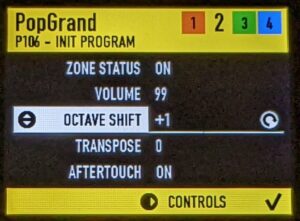 I did this with 4 acoustic grand pianos and played them 2 at a time, 3 at a time, and all 4 at one time. The combination sound of having, as an example, a Japanese Yamaha grand with a German Steinway grand piano was really cool and created a grand piano sound you cannot get by using those individual grand piano sounds by themselves. You can also alter the octave of each grand piano sound or split them into zones across the keyboard.
I did this with 4 acoustic grand pianos and played them 2 at a time, 3 at a time, and all 4 at one time. The combination sound of having, as an example, a Japanese Yamaha grand with a German Steinway grand piano was really cool and created a grand piano sound you cannot get by using those individual grand piano sounds by themselves. You can also alter the octave of each grand piano sound or split them into zones across the keyboard.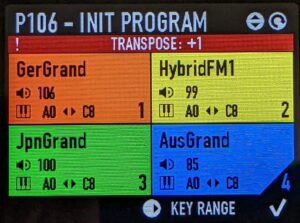 An example of a cool program that is not about acoustic pianos is you can setup and save up 4 different vintage electric piano sounds in one program which sounds very impressive when you do that. You could also combine 1, 2, or 3 vintage electric piano sounds together with grand pianos to enhance the piano sound mix. This works very well and can give you hundreds of piano layer possibilities.
An example of a cool program that is not about acoustic pianos is you can setup and save up 4 different vintage electric piano sounds in one program which sounds very impressive when you do that. You could also combine 1, 2, or 3 vintage electric piano sounds together with grand pianos to enhance the piano sound mix. This works very well and can give you hundreds of piano layer possibilities.PANEL PUSH KNOBS – VOLUME & MUTE CONTROL
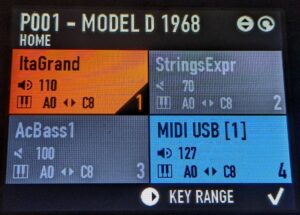 Another very interesting and useful feature of this 4 instrument mode is that when you have 2,3, or 4 instrument sounds layered together, if you want to mute one of those sounds all you have to do is just quickly push on the top of the volume (encoder) knob that corresponds with that sound and then that sound is muted. The color display quadrant of that sound turns to a dark gray color so you know it’s muted. If you want that sound to come on again you just push the top of that specific volume knob and then the muted sound light ups again in the appropriate color and it’s part of the mix again.
Another very interesting and useful feature of this 4 instrument mode is that when you have 2,3, or 4 instrument sounds layered together, if you want to mute one of those sounds all you have to do is just quickly push on the top of the volume (encoder) knob that corresponds with that sound and then that sound is muted. The color display quadrant of that sound turns to a dark gray color so you know it’s muted. If you want that sound to come on again you just push the top of that specific volume knob and then the muted sound light ups again in the appropriate color and it’s part of the mix again.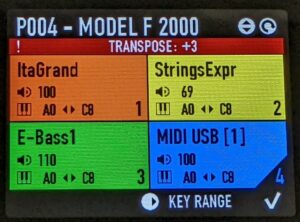 Beyond that there’s another very useful feature in that user interface that really helped me when I was playing 4 sounds at one time on the XGT. If I was playing a grand piano, organ, strings, and synth sound layered altogether in one program that I created, and I wanted to “solo out” with the grand piano sound in part of the song and not hear the other instruments I had selected, then instead of individually muting the other 3 instrument sounds one at a time by pressing the each volume knobs, all I had to do was press and hold (for a couple seconds) the volume (encoder) knob that corresponded with that grand piano sound.
Beyond that there’s another very useful feature in that user interface that really helped me when I was playing 4 sounds at one time on the XGT. If I was playing a grand piano, organ, strings, and synth sound layered altogether in one program that I created, and I wanted to “solo out” with the grand piano sound in part of the song and not hear the other instruments I had selected, then instead of individually muting the other 3 instrument sounds one at a time by pressing the each volume knobs, all I had to do was press and hold (for a couple seconds) the volume (encoder) knob that corresponded with that grand piano sound.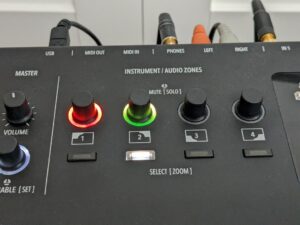 Once I pressed and held down the know for the instrument that I want to play by itself, then the other 3 sounds were instantly muted and those knob lights went out. That way I could play a solo part with that grand piano sound alone and then bring in those other parts if and when I wanted them to come back in. When I selected those muted parts again then those specific knob lights were also lit up again. This is a very cool feature and one that I often took advantage of. Very smart engineering and design of the user interface. You can do this with any of the (up to) 4 layered parts.
Once I pressed and held down the know for the instrument that I want to play by itself, then the other 3 sounds were instantly muted and those knob lights went out. That way I could play a solo part with that grand piano sound alone and then bring in those other parts if and when I wanted them to come back in. When I selected those muted parts again then those specific knob lights were also lit up again. This is a very cool feature and one that I often took advantage of. Very smart engineering and design of the user interface. You can do this with any of the (up to) 4 layered parts.MAIN USER INTERFACE – CONCLUSIONS
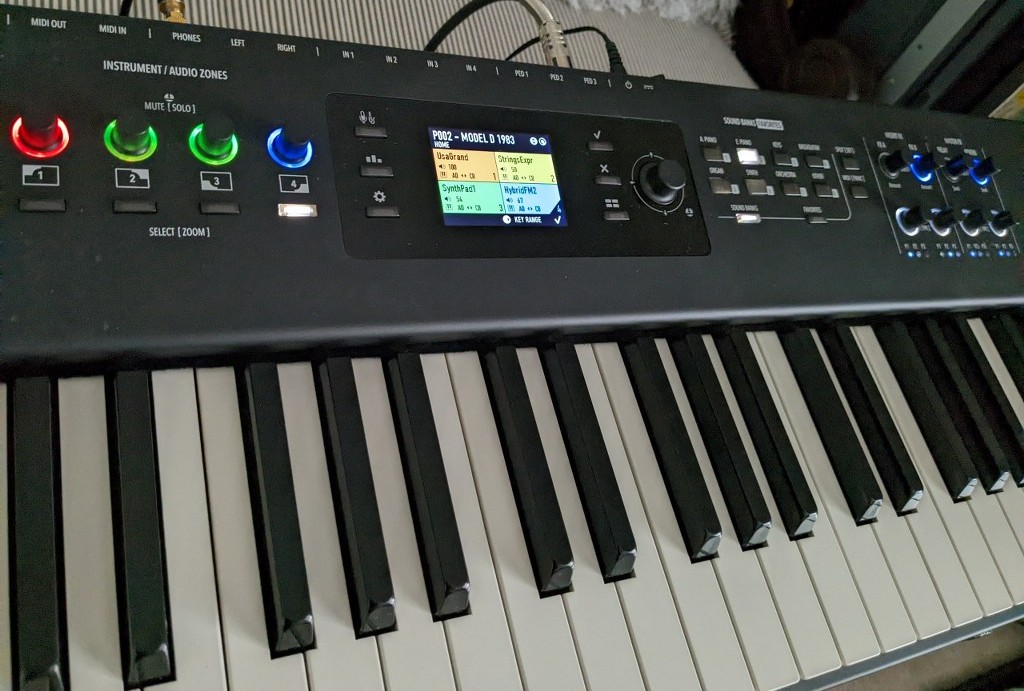
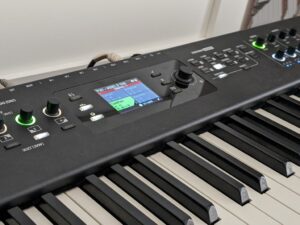 In my opinion, the Studiologic XGT is easy enough to learn and use that it could easily be a great instrument for someone at home for recreational playing, for a church, for a school, for a home music studio, and not just for pro players on stage or in pro recording studios. It just depends if this type of piano “slab” cabinet format (a portable, metal digital piano with no internal speakers) would work well for your needs. Regardless, this XGT user interface control panel definitely makes it easier to get what you want out of it and play great music.
In my opinion, the Studiologic XGT is easy enough to learn and use that it could easily be a great instrument for someone at home for recreational playing, for a church, for a school, for a home music studio, and not just for pro players on stage or in pro recording studios. It just depends if this type of piano “slab” cabinet format (a portable, metal digital piano with no internal speakers) would work well for your needs. Regardless, this XGT user interface control panel definitely makes it easier to get what you want out of it and play great music.SOUND LIBRARY INTERFACE MENUS
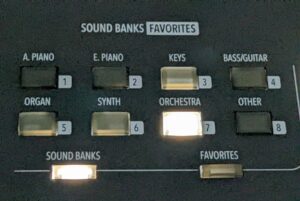 The XGT has a library of 218 sounds and 2 percussion kits as I previously mention. The library of instrument sounds are divided up into 8 sub categories or groups called “sound banks.” There is a button that light up to let you know you are using the sound banks. Within those sound banks are pianos, electric pianos, organs, strings, etc. In each sound bank group there are anywhere from 15 to 50 sounds and you can quickly scroll through those sounds with a knob in the user interface.
The XGT has a library of 218 sounds and 2 percussion kits as I previously mention. The library of instrument sounds are divided up into 8 sub categories or groups called “sound banks.” There is a button that light up to let you know you are using the sound banks. Within those sound banks are pianos, electric pianos, organs, strings, etc. In each sound bank group there are anywhere from 15 to 50 sounds and you can quickly scroll through those sounds with a knob in the user interface.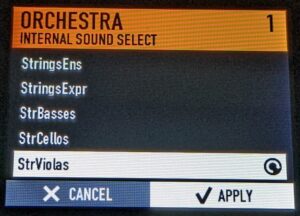 It’s easy to do and you can “audition” the individual sounds that way by being able to play them individually. You can then assign any of those sounds to an individual program with up to 4 sounds per program as I have already discussed. You can individually adjust the volume, characteristics, and effects of each sound so that you have them the way you want them. Then you save those individual sounds to a program (there are 250 programs available in the XGT) and you can use any of those programs and individual sounds whenever you want to.
It’s easy to do and you can “audition” the individual sounds that way by being able to play them individually. You can then assign any of those sounds to an individual program with up to 4 sounds per program as I have already discussed. You can individually adjust the volume, characteristics, and effects of each sound so that you have them the way you want them. Then you save those individual sounds to a program (there are 250 programs available in the XGT) and you can use any of those programs and individual sounds whenever you want to.FAVORITES
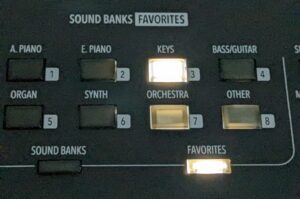 To make life easier in finding the sounds you saved into all those programs, the XGT has a “Favorites” menu that you enter by pressing the light up “favorites button. You can set up your saved sounds and programs in the “favorites” section so that you can quickly and intuitive access them. You can place your saved programs in any order and under any name that you create and then can move from one program to another by way of a turning a knob or even using the triple pedal unit to move from one sound program to another by using your foot and pressing down on a pedal as opposed to using your fingers to turn a knob.
To make life easier in finding the sounds you saved into all those programs, the XGT has a “Favorites” menu that you enter by pressing the light up “favorites button. You can set up your saved sounds and programs in the “favorites” section so that you can quickly and intuitive access them. You can place your saved programs in any order and under any name that you create and then can move from one program to another by way of a turning a knob or even using the triple pedal unit to move from one sound program to another by using your foot and pressing down on a pedal as opposed to using your fingers to turn a knob.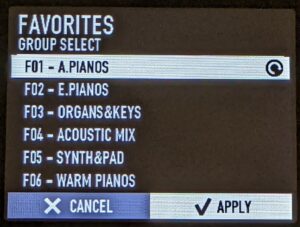 There are 16 groups designated for the saved programs and the XGT allows you to insert 24 programs per group giving you a total of 384 “Favorite” programs that you have customized and set up in a certain order that meets your musical needs. Now remember, you would have up to 4 instrument sounds which are in each program. So if you take 4 sounds per program x 384 of your favorite programs , that gives you1,536 possibilities for the sounds that you have set up including layers and splits along with external sounds coming from external devices that become part of the program.
There are 16 groups designated for the saved programs and the XGT allows you to insert 24 programs per group giving you a total of 384 “Favorite” programs that you have customized and set up in a certain order that meets your musical needs. Now remember, you would have up to 4 instrument sounds which are in each program. So if you take 4 sounds per program x 384 of your favorite programs , that gives you1,536 possibilities for the sounds that you have set up including layers and splits along with external sounds coming from external devices that become part of the program.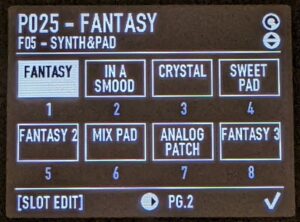 It’s always the “bread & butter” internal sounds that I care about, which the XGT has. Then I can enhance my music by occasionally bringing in an external sound using USB audio streaming connecting to an external device like an iPad or laptop and using software sounds if needed. But most of the sounds in the XGT are already outstanding as compared to most other digital pianos under $3000. Even the Hammond B3 organ sounds are reproduced in a very convincing way. The “Favorites Menus” let’s me organize everything in an intuitive and convenient way so I can quickly get to the sounds I want or need and have them already set up as layers, splits, combinations, or just one sound at a time, including the effects that I want. The Favorites menu is a great feature to have in this model and it’s something that I would use all the time.
It’s always the “bread & butter” internal sounds that I care about, which the XGT has. Then I can enhance my music by occasionally bringing in an external sound using USB audio streaming connecting to an external device like an iPad or laptop and using software sounds if needed. But most of the sounds in the XGT are already outstanding as compared to most other digital pianos under $3000. Even the Hammond B3 organ sounds are reproduced in a very convincing way. The “Favorites Menus” let’s me organize everything in an intuitive and convenient way so I can quickly get to the sounds I want or need and have them already set up as layers, splits, combinations, or just one sound at a time, including the effects that I want. The Favorites menu is a great feature to have in this model and it’s something that I would use all the time.INTERNAL ORGAN SOUNDS INCL HAMMOND B3
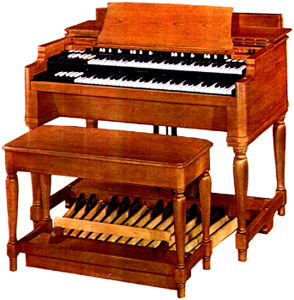 Some digital piano controller models from other brands have digital “drawbars/tonebars” that recreate that Hammond organ drawbar experience so that you can make subtle changes to your jazz, rock, or gospel organ sounds and that can be a cool feature. I have played many Hammond B3’s over the years because I also play organ, so I know what that’s like.
Some digital piano controller models from other brands have digital “drawbars/tonebars” that recreate that Hammond organ drawbar experience so that you can make subtle changes to your jazz, rock, or gospel organ sounds and that can be a cool feature. I have played many Hammond B3’s over the years because I also play organ, so I know what that’s like.FAVORITES & SOUND SETUPS – CONCLUSIONS
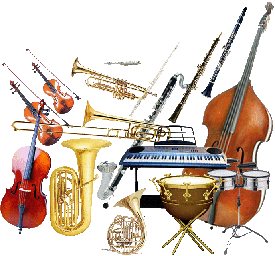 When it comes to the instrument sounds, customizing them, setting them up in programs and then saving them to “Favorites” so you can access them quickly, the XGT does an excellent job in that way. This is mostly what “players” care about…great sounds, easy access, setting them up in an intuitive way, and being able to make great music with those sounds. Also, it’s easy and quick to edit those programs, sounds, and favorites so your not spending too much time on “operation” and you’re spending more time playing your music. This is how I felt about the XGT after playing it for many hours over many days.
When it comes to the instrument sounds, customizing them, setting them up in programs and then saving them to “Favorites” so you can access them quickly, the XGT does an excellent job in that way. This is mostly what “players” care about…great sounds, easy access, setting them up in an intuitive way, and being able to make great music with those sounds. Also, it’s easy and quick to edit those programs, sounds, and favorites so your not spending too much time on “operation” and you’re spending more time playing your music. This is how I felt about the XGT after playing it for many hours over many days.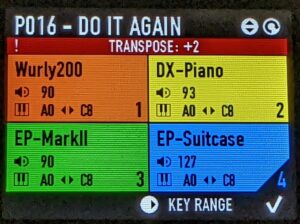 At this point so far I have talked about the primary things in this model that are most important to digital piano shoppers and that is the piano playing experience realism and the instrument sound experience realism. If those two areas are not impressive and practical then the rest of it really doesn’t matter in my opinion. But since those two primary areas are very good, and in some ways exceptional as compared to other brands & models, then the user interface becomes important. In the XGT, the interface and control panel are especially intuitive and overall easy to use.
At this point so far I have talked about the primary things in this model that are most important to digital piano shoppers and that is the piano playing experience realism and the instrument sound experience realism. If those two areas are not impressive and practical then the rest of it really doesn’t matter in my opinion. But since those two primary areas are very good, and in some ways exceptional as compared to other brands & models, then the user interface becomes important. In the XGT, the interface and control panel are especially intuitive and overall easy to use.EFFECTS & CONTROL
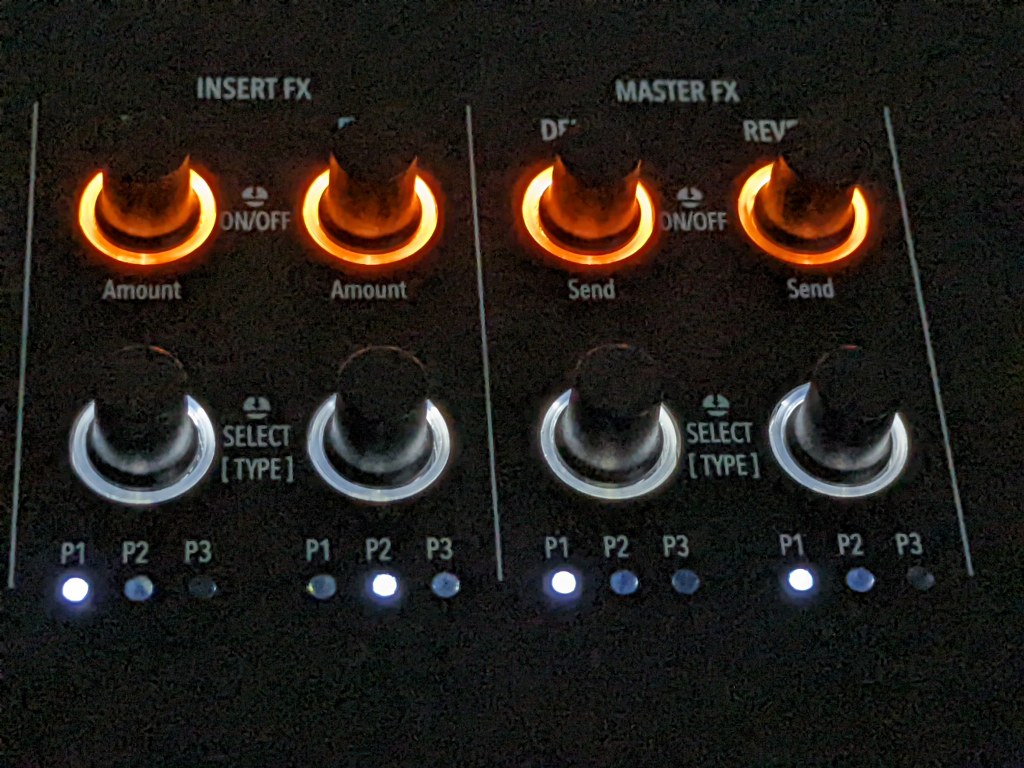
So now we move on to the master and insert effects section which take up a relatively large part of the user interface panel. There are 8 effects controller knobs (encoders) which can be turned in either direction to control digital effects features as well as being push knobs to control on/off functions as well selecting different parameters of the effects. The 8 knobs are divided up into sections with 4 of them for master effects and 4 of them for insert effects. There is a master reverb and master delay and also the insert FX A and insert FX B.
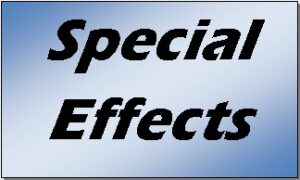 The effects section is an essential and integral part of any semi-pro or pro digital piano because the effects will give many instruments the extra organic sound elements they need to sound even more authentic. This is true for acoustic piano sounds, electric pianos, organs, synths, guitars, strings, pads, and most other sounds. Nearly every digital piano out there has some basic effects such as a basic reverb/echo sound and/or chorus for electric pianos, guitar, etc. But just because a digital piano has some effects built-in, that doesn’t mean they sound good.
The effects section is an essential and integral part of any semi-pro or pro digital piano because the effects will give many instruments the extra organic sound elements they need to sound even more authentic. This is true for acoustic piano sounds, electric pianos, organs, synths, guitars, strings, pads, and most other sounds. Nearly every digital piano out there has some basic effects such as a basic reverb/echo sound and/or chorus for electric pianos, guitar, etc. But just because a digital piano has some effects built-in, that doesn’t mean they sound good.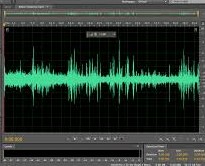 The quality of the built-in effects can also vary quite a bit. There are low quality effects such as low quality reverb, chorus, EQ, etc, in many digital pianos just like there are low quality instrument sounds. Low quality effects makes the instruments sound much more artificial and more like toys. The XGT effects are stage & recording studio quality and you won’t be disappointed. I certainly was impressed with them and I felt like they added a lot to the music listening and performing experience of the XGT, and they were easy to use and control.
The quality of the built-in effects can also vary quite a bit. There are low quality effects such as low quality reverb, chorus, EQ, etc, in many digital pianos just like there are low quality instrument sounds. Low quality effects makes the instruments sound much more artificial and more like toys. The XGT effects are stage & recording studio quality and you won’t be disappointed. I certainly was impressed with them and I felt like they added a lot to the music listening and performing experience of the XGT, and they were easy to use and control.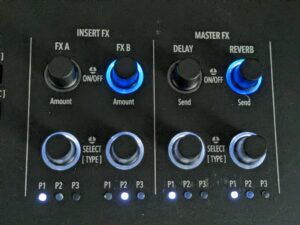 There are 35 total separate instrument effects in the XGT divided into 4 sections. I already mentioned those 4 sections earlier. You would have 8 total knobs (encoders) to control these different instrument effects with 1 row of 4 knobs on top and another row of 4 knobs underneath. The top row of encoder knobs select the type of effect as well increasing or decreasing the amount of that effect you want along with turning them on or off. The bottom knobs select the parameters of each effect and the intensity of those parameters. There are 3 effect parameters per main effect. There are 3 light indicators showing which parameter is being used. When the top encoder knobs are lit up then that’s when you know that effect is on and being applied to the sounds you have in your programs.
There are 35 total separate instrument effects in the XGT divided into 4 sections. I already mentioned those 4 sections earlier. You would have 8 total knobs (encoders) to control these different instrument effects with 1 row of 4 knobs on top and another row of 4 knobs underneath. The top row of encoder knobs select the type of effect as well increasing or decreasing the amount of that effect you want along with turning them on or off. The bottom knobs select the parameters of each effect and the intensity of those parameters. There are 3 effect parameters per main effect. There are 3 light indicators showing which parameter is being used. When the top encoder knobs are lit up then that’s when you know that effect is on and being applied to the sounds you have in your programs.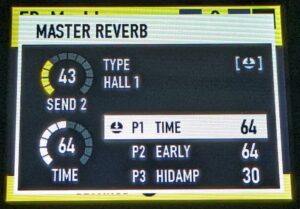 There are 3 parameters per effect that you can control and you know which parameter you are controlling because you can select them individually by pressing the corresponding controller encoder knob and then a led light under each bottom row knob will light up and show you which parameter has been selected. So you can easily see what’s going on even in a darker area. This is a very convenient feature and they work well. The knobs feel good and turn easy and selecting the amount of each parameter you need simply requires you to turn the knob one way of the other. Very easy.
There are 3 parameters per effect that you can control and you know which parameter you are controlling because you can select them individually by pressing the corresponding controller encoder knob and then a led light under each bottom row knob will light up and show you which parameter has been selected. So you can easily see what’s going on even in a darker area. This is a very convenient feature and they work well. The knobs feel good and turn easy and selecting the amount of each parameter you need simply requires you to turn the knob one way of the other. Very easy.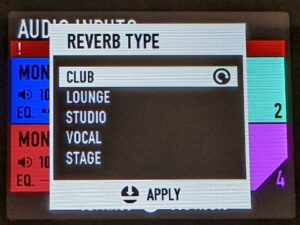 There are also 14 special vocal effects (in the reverb effects section) that come up when you plug a microphone into the XGT. You can plug in up to 4 separate mics and control them independently along with those vocal effects. These effects include pro vocal reverbs and delays. I will talk more about inserting microphones a bit later, but the effects for the microphones are really good and if you are going to be doing and singing then those special effects are essential to your singing. The vocal reverb and delay effects are separate and distinct from the instrument reverb and delay effects and only work when a mic is plugged in.
There are also 14 special vocal effects (in the reverb effects section) that come up when you plug a microphone into the XGT. You can plug in up to 4 separate mics and control them independently along with those vocal effects. These effects include pro vocal reverbs and delays. I will talk more about inserting microphones a bit later, but the effects for the microphones are really good and if you are going to be doing and singing then those special effects are essential to your singing. The vocal reverb and delay effects are separate and distinct from the instrument reverb and delay effects and only work when a mic is plugged in.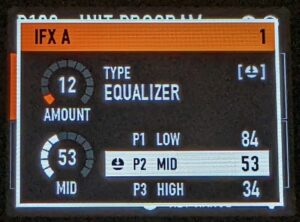 There is also separate EQ controls for each of the 4 instrument zones per program so that you can add more or less bass, more or less mid-range, more or less treble to each sound. You can control these different things quickly and efficiently and it is easy to do. Customizable, quality EQ settings for each instrument is also essential for adding to the realism of the instrumentals. For vocal EQ you would use the master EQ section for the entire instrument.
There is also separate EQ controls for each of the 4 instrument zones per program so that you can add more or less bass, more or less mid-range, more or less treble to each sound. You can control these different things quickly and efficiently and it is easy to do. Customizable, quality EQ settings for each instrument is also essential for adding to the realism of the instrumentals. For vocal EQ you would use the master EQ section for the entire instrument.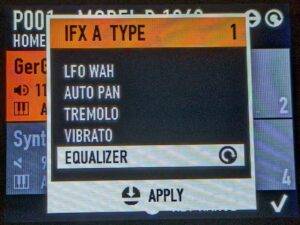 The effects are excellent, very pro quality for those people who need something “better” and each parameter of an effect can also be tweaked and controlled by the additional encoder knobs. This gives you the ability to customize the sounds you are using and then save all those effects into your instrument sound programs and they will be recalled instantly the next time you play those sounds.
The effects are excellent, very pro quality for those people who need something “better” and each parameter of an effect can also be tweaked and controlled by the additional encoder knobs. This gives you the ability to customize the sounds you are using and then save all those effects into your instrument sound programs and they will be recalled instantly the next time you play those sounds.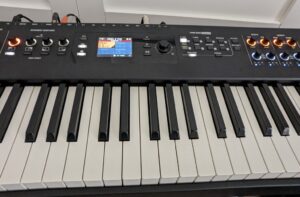 Color coded and easy to see controls is another thing the XGT does well and they did the color coding thing not only with the instruments, as I mentioned earlier in this review, but also with this effects section. This means that when you want to add effects to an instrument within a program, then that instrument is color coded and coordinates with the same color in the effects section. So that way you know which sound you are adding the effects to. Everything is color coded. When all these features become easier to handle and manipulate as they are in the XGT, you will tend to use them more often and take advantage of what they can do…and all that works very well in this Studiologic model.
Color coded and easy to see controls is another thing the XGT does well and they did the color coding thing not only with the instruments, as I mentioned earlier in this review, but also with this effects section. This means that when you want to add effects to an instrument within a program, then that instrument is color coded and coordinates with the same color in the effects section. So that way you know which sound you are adding the effects to. Everything is color coded. When all these features become easier to handle and manipulate as they are in the XGT, you will tend to use them more often and take advantage of what they can do…and all that works very well in this Studiologic model.MODULATION & PITCH BEND CONTROLLERS
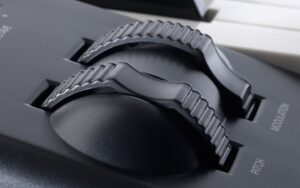 A couple of other effects controls that many stage digital pianos and keyboards have on them are called the modulation and pitch bend effects wheels. Different brands offer different configurations and designs when it comes to the physical parts that control these effects. They can either be 2 movable “wheels” on the left side of the keys, above the keys, or next to them or they can be in one movable controller that can do both effects within one controller, sometimes called a joystick. This image here is an example of what you might normally find on a stage type/recording studio digital piano or keyboard. The XGT does not have this type of wheel controller.
A couple of other effects controls that many stage digital pianos and keyboards have on them are called the modulation and pitch bend effects wheels. Different brands offer different configurations and designs when it comes to the physical parts that control these effects. They can either be 2 movable “wheels” on the left side of the keys, above the keys, or next to them or they can be in one movable controller that can do both effects within one controller, sometimes called a joystick. This image here is an example of what you might normally find on a stage type/recording studio digital piano or keyboard. The XGT does not have this type of wheel controller.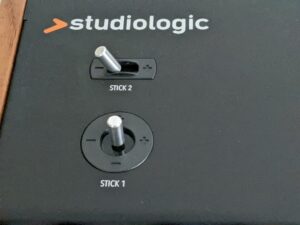 On the XGT, the Studiologic company put in 2 convenient controllers which they call “sticks.” They are independent of each other, small, and easily movable silver sticks with one of them able to move in any direction up or down and side to side or in circles. That one is called stick #1 and it can be assigned with 2 functions (X & Y) such as pitch bend and modulation in one controller. The controller stick always settles back into the center when it is not being used.
On the XGT, the Studiologic company put in 2 convenient controllers which they call “sticks.” They are independent of each other, small, and easily movable silver sticks with one of them able to move in any direction up or down and side to side or in circles. That one is called stick #1 and it can be assigned with 2 functions (X & Y) such as pitch bend and modulation in one controller. The controller stick always settles back into the center when it is not being used.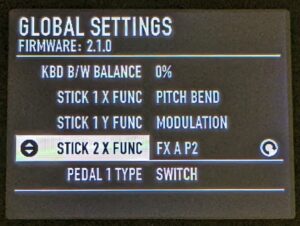 Both sticks are assignable from the main menu display to control different effects such as modulation (vibrato), pitch bend, enabling different FX effects, etc. These sticks are located all the way to the far left side of the piano where they are out of the way but yet in a good position. They are not big and bulky like other controllers (wheels) can be and they look good too. Each stick is easy to use and comfortable to hold and control. I personally like their size and feel and they are a very nice alternative to the bigger bulkier wheels or joysticks that you would likely find on other brands and models.
Both sticks are assignable from the main menu display to control different effects such as modulation (vibrato), pitch bend, enabling different FX effects, etc. These sticks are located all the way to the far left side of the piano where they are out of the way but yet in a good position. They are not big and bulky like other controllers (wheels) can be and they look good too. Each stick is easy to use and comfortable to hold and control. I personally like their size and feel and they are a very nice alternative to the bigger bulkier wheels or joysticks that you would likely find on other brands and models.CONNECTIVITY HARDWARE & FUNCTIONS
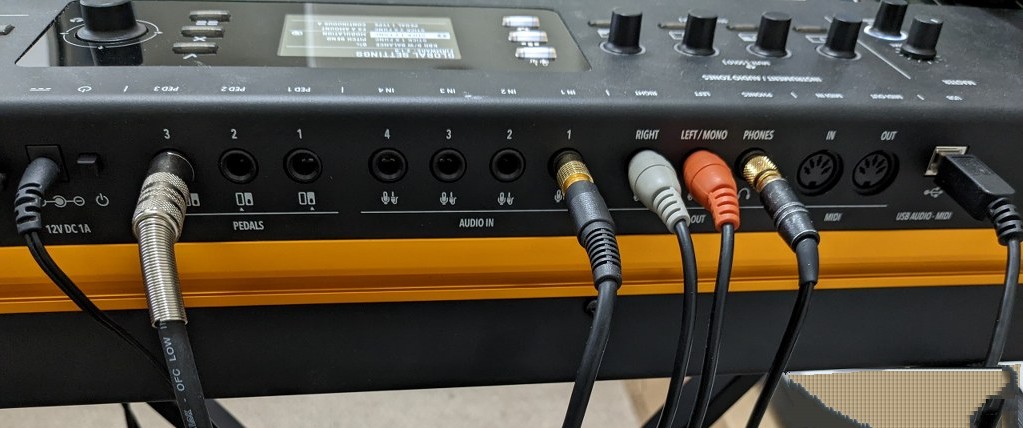
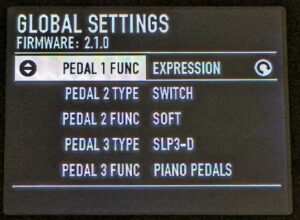 Having three pedal options allows you to control 3 functions with the triple pedal unit that is included with the XGT, and those functions can be the traditional piano pedals or you can also assign different functions to that triple pedal unit in the Global settings feature. Then on top of that you can connect two single pedals to the XGT to control other functions such as expression or other pedal setups that you can do. In that way you have a variety of functions you can quickly control with your pedals and its especially helpful when playing live on stage, in a recording home or pro recording studio, etc.
Having three pedal options allows you to control 3 functions with the triple pedal unit that is included with the XGT, and those functions can be the traditional piano pedals or you can also assign different functions to that triple pedal unit in the Global settings feature. Then on top of that you can connect two single pedals to the XGT to control other functions such as expression or other pedal setups that you can do. In that way you have a variety of functions you can quickly control with your pedals and its especially helpful when playing live on stage, in a recording home or pro recording studio, etc.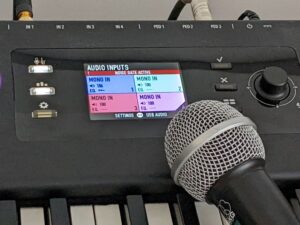 The TS/mono audio inputs are for controlling and mixing microphones or external electronic instruments or recording devices that you want to connect into the XGT. If you wanted to do something fairly simple and you had a few people who you wanted to do vocals with you, then you can connect up to 4 microphones to the XGT and control each microphone independently for individual volumes and effects so that each voice blends together perfectly while you play the XGT live.
The TS/mono audio inputs are for controlling and mixing microphones or external electronic instruments or recording devices that you want to connect into the XGT. If you wanted to do something fairly simple and you had a few people who you wanted to do vocals with you, then you can connect up to 4 microphones to the XGT and control each microphone independently for individual volumes and effects so that each voice blends together perfectly while you play the XGT live.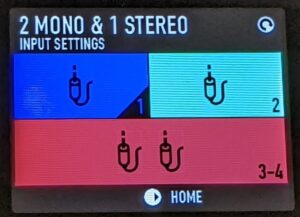 Essentially you have a 4-channel audio mixer built into the XGT for complete control as well as being able to quickly mute any of those audio channels when you don’t need them. You can set up the four audio inputs in any digital configuration including 2 mono/1 stereo, 4 mono, 2 stereo, etc. It’s easy to do those setups and helps give you the type of audio preproduction that you need and to be able to mix those signals together to achieve the desired audio outcome for the devices you are using and controlling within the XGT. There are also audio input digital EQ controls for quick changes on the EQ settings for any audio device, mic, etc that you connect to the XGT.
Essentially you have a 4-channel audio mixer built into the XGT for complete control as well as being able to quickly mute any of those audio channels when you don’t need them. You can set up the four audio inputs in any digital configuration including 2 mono/1 stereo, 4 mono, 2 stereo, etc. It’s easy to do those setups and helps give you the type of audio preproduction that you need and to be able to mix those signals together to achieve the desired audio outcome for the devices you are using and controlling within the XGT. There are also audio input digital EQ controls for quick changes on the EQ settings for any audio device, mic, etc that you connect to the XGT.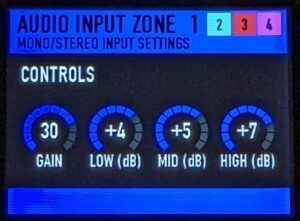 The connector array on the back is clearly labeled in small white lettering on the top back of the XGT. The names of those connectors are written right above where they are located as well as on the top of the XGT so that you can easily figure out where each of those jacks and ports are located for quick access. This is very helpful because I have run into brands and models where you don’t know where they are located because there is no indication of their position or you cannot see them clearly.
The connector array on the back is clearly labeled in small white lettering on the top back of the XGT. The names of those connectors are written right above where they are located as well as on the top of the XGT so that you can easily figure out where each of those jacks and ports are located for quick access. This is very helpful because I have run into brands and models where you don’t know where they are located because there is no indication of their position or you cannot see them clearly.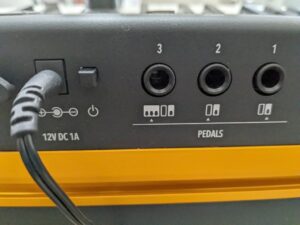 The power button and power supply input are within the lineup of connectors in the back of the XGT near the center, so they are within easy reach of everything. Having it that way is very helpful instead of the power supply and power buttons being on the far left or right side of the back of the piano like some other models do. However, I wish the stereo headphone jack was on the front left of the XGT for easier access and I would have preferred it that way. It’s on the back and unfortunately that’s fairly typical. I suppose it saves the company a bit of money to have it on the back with the rest of the connectors.
The power button and power supply input are within the lineup of connectors in the back of the XGT near the center, so they are within easy reach of everything. Having it that way is very helpful instead of the power supply and power buttons being on the far left or right side of the back of the piano like some other models do. However, I wish the stereo headphone jack was on the front left of the XGT for easier access and I would have preferred it that way. It’s on the back and unfortunately that’s fairly typical. I suppose it saves the company a bit of money to have it on the back with the rest of the connectors.GLOBAL SETTINGS
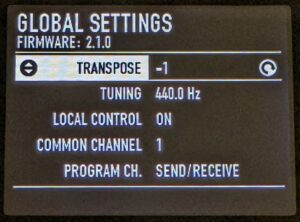 Most stage and other portable digital pianos have Global settings. Global setting have useful functions that apply to all sounds on the piano rather to specific sounds, programs, or favorites. As an example if you want to modulate your key and transpose your musical, then you can go into the Global settings section by pressing the settings button and the first function you will see is “transpose.”
Most stage and other portable digital pianos have Global settings. Global setting have useful functions that apply to all sounds on the piano rather to specific sounds, programs, or favorites. As an example if you want to modulate your key and transpose your musical, then you can go into the Global settings section by pressing the settings button and the first function you will see is “transpose.”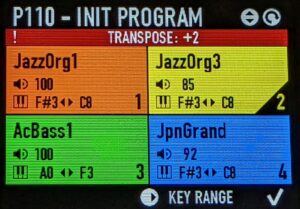 In other words the transpose function will allow you to move from one key to the next in a very smooth way without having any of the sounds cut out. You can always see what transposed key you are in because in the main home screen the transposed key will show up in a smaller red row at the top of the home screen. This is very useful to know where you are at if you have transposed the music you are playing.
In other words the transpose function will allow you to move from one key to the next in a very smooth way without having any of the sounds cut out. You can always see what transposed key you are in because in the main home screen the transposed key will show up in a smaller red row at the top of the home screen. This is very useful to know where you are at if you have transposed the music you are playing.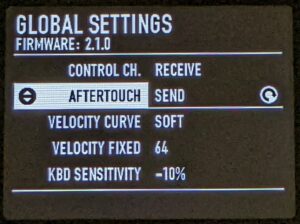 Other Global functions would include setting up your assignable pedals, sticks, MIDI channels, after-touch, velocity curve, keyboard sensitivity, etc. These settings can be very useful, especially the velocity curve depending on which instruments or sounds you are playing. For instance, sometimes you would want a sound like a synth or trumpet, or electric guitar to respond more quickly when you touch the keys than you would for piano and other instruments. So then you set the velocity curve on soft to play certain sounds more accurately.
Other Global functions would include setting up your assignable pedals, sticks, MIDI channels, after-touch, velocity curve, keyboard sensitivity, etc. These settings can be very useful, especially the velocity curve depending on which instruments or sounds you are playing. For instance, sometimes you would want a sound like a synth or trumpet, or electric guitar to respond more quickly when you touch the keys than you would for piano and other instruments. So then you set the velocity curve on soft to play certain sounds more accurately.
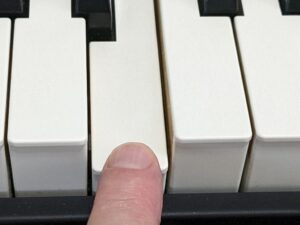 After-touch control is also a big deal to some players out there because you can add vibrato to any sound by simply pressing down any key harder after you have already pushed down a key to the bottom. Once the key is depressed all the way down, then you hold it there and press again harder. When you do this it triggers a vibrato effect for the sound on that key. such as what you might want to do for a violin, guitar, or other instruments. Typically it’s the pro stage digital pianos and keyboards that would have “after-touch.”
After-touch control is also a big deal to some players out there because you can add vibrato to any sound by simply pressing down any key harder after you have already pushed down a key to the bottom. Once the key is depressed all the way down, then you hold it there and press again harder. When you do this it triggers a vibrato effect for the sound on that key. such as what you might want to do for a violin, guitar, or other instruments. Typically it’s the pro stage digital pianos and keyboards that would have “after-touch.”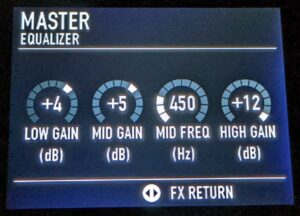 There is also a separate global 4-band master EQ feature that allows you to quickly adjust the EQ levels for the entire instrument. You use the 4 encoder knobs to the left of the display screen to adjust each of the EQ bands and you can also adjust the master reverb and master delay intensity for the piano as well The master EQ is easy to use and right at your fingertips for quick overall adjustments when you need it. There are other useful Global features and settings depending on what you need for the music you are playing.
There is also a separate global 4-band master EQ feature that allows you to quickly adjust the EQ levels for the entire instrument. You use the 4 encoder knobs to the left of the display screen to adjust each of the EQ bands and you can also adjust the master reverb and master delay intensity for the piano as well The master EQ is easy to use and right at your fingertips for quick overall adjustments when you need it. There are other useful Global features and settings depending on what you need for the music you are playing.
FINAL THOUGHTS & CONCLUSIONS
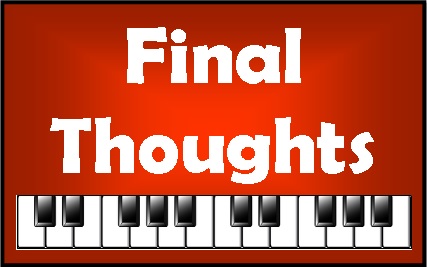
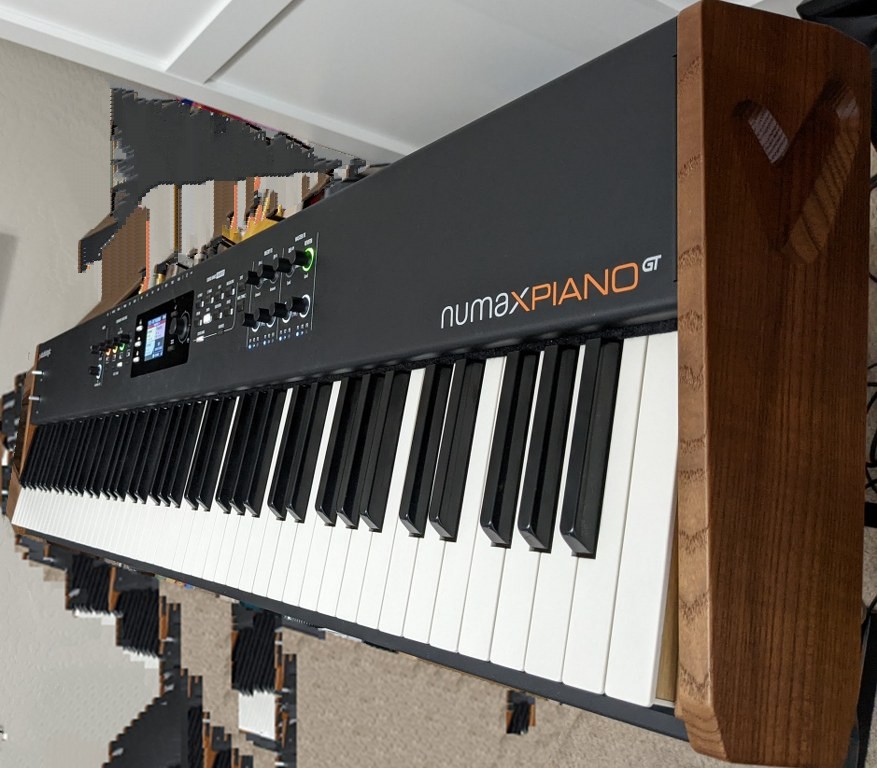
The XGT not only has a good looking control panel and layout but as I mentioned already, it is user friendly and intuitive to control once you have don’t it a few times. The cabinet (case) finish on the XGT is in slightly textured matte black and feels good to the touch. The designer wooden sides on the XGT made out of ash wood really makes this model look elegant and gives it some “class” in my opinion. The special design allows you to see real wood grain and the corners of those sounds are rounded a bit and the exterior is slightly beveled and looks great.
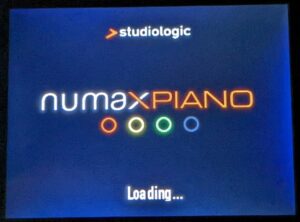 I really like that the cabinet (case) is not just a plain black slab. The controls, knobs, and buttons have that organic retro feel to them as opposed to some that are much more contemporary with embedded touch sensor buttons, touchscreens, or a combination of all three. So when it comes to a control panel user interface and layout, the XGT is comfortable to use and fairly easy to figure out, and I really like that 4-part color screen with corresponding color control knobs for the instrument sounds and effects section. The connectivity is there and pretty much what most people would need.
I really like that the cabinet (case) is not just a plain black slab. The controls, knobs, and buttons have that organic retro feel to them as opposed to some that are much more contemporary with embedded touch sensor buttons, touchscreens, or a combination of all three. So when it comes to a control panel user interface and layout, the XGT is comfortable to use and fairly easy to figure out, and I really like that 4-part color screen with corresponding color control knobs for the instrument sounds and effects section. The connectivity is there and pretty much what most people would need. The Studiologic digital pianos have a factory warranty of 2 years parts and 1 year labor. That warranty is OK but not great. There are some factory warranties for other brands that have a shorter warranty time than the Studiologic models and some that have longer warranties. Stage or pro studio digital pianos like this one typically have shorter warranties because the manufacturer knows (because of experience) that pro players and studios will be rougher and harder on these models and give them more wear and tear, dropping them, banging them up, etc. If this model and others like it was strictly a “home studio”, or home portable piano in general, then the warranty would likely be noticeably longer.
The Studiologic digital pianos have a factory warranty of 2 years parts and 1 year labor. That warranty is OK but not great. There are some factory warranties for other brands that have a shorter warranty time than the Studiologic models and some that have longer warranties. Stage or pro studio digital pianos like this one typically have shorter warranties because the manufacturer knows (because of experience) that pro players and studios will be rougher and harder on these models and give them more wear and tear, dropping them, banging them up, etc. If this model and others like it was strictly a “home studio”, or home portable piano in general, then the warranty would likely be noticeably longer. There are a few things this model does not have that I would have liked. It doesn’t have Bluetooth wireless MIDI or USB audio streaming, no recording of any kind, no USB thumb-drive slot for general storage which is mostly used for saving or loading songs, and this model does not have it. There are no drum rhythm patterns, there is not 500 or more internal sounds, and there are no digital drawbars for Hammond style organ sound adjustments. But what it does have is very impressive and will serve most people’s musical needs quite well.
There are a few things this model does not have that I would have liked. It doesn’t have Bluetooth wireless MIDI or USB audio streaming, no recording of any kind, no USB thumb-drive slot for general storage which is mostly used for saving or loading songs, and this model does not have it. There are no drum rhythm patterns, there is not 500 or more internal sounds, and there are no digital drawbars for Hammond style organ sound adjustments. But what it does have is very impressive and will serve most people’s musical needs quite well.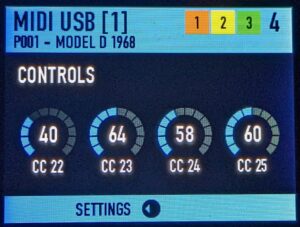 If you want the XGT to do “more” then you can always use an iPad or computer for connecting with external instrument sounds, percussion, drum rhythms, etc. You can also connect with a desktop and use the Studiologic proprietary Numa Manager controller app for loading in new sounds to the XGT (which is very cool) as well as using that app to further control and manipulate your saved programs as well as do firmware updates when needed and available. So even those aspects of controlling and using the XGT externally are there and available which opens up many more possibilities if you need them.
If you want the XGT to do “more” then you can always use an iPad or computer for connecting with external instrument sounds, percussion, drum rhythms, etc. You can also connect with a desktop and use the Studiologic proprietary Numa Manager controller app for loading in new sounds to the XGT (which is very cool) as well as using that app to further control and manipulate your saved programs as well as do firmware updates when needed and available. So even those aspects of controlling and using the XGT externally are there and available which opens up many more possibilities if you need them.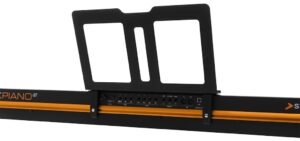 This Numa X Piano GT by Studiologic checks almost all the boxes for me when it comes to a home studio, pro recording studio, and stage digital piano, especially in this price range under $2000. Plus there are 3 optional accessory pieces (for an extra cost) you can add to the XGT which include a magnetic music stand, a magnetic computer plate, and a carrying case. The magnetic accessories are definitely useful and Studiologic provided an attractive copper color magnetic strip on the back of the XGT so that either the music stand and/or computer stand can be easily attached. They look cool and work good.
This Numa X Piano GT by Studiologic checks almost all the boxes for me when it comes to a home studio, pro recording studio, and stage digital piano, especially in this price range under $2000. Plus there are 3 optional accessory pieces (for an extra cost) you can add to the XGT which include a magnetic music stand, a magnetic computer plate, and a carrying case. The magnetic accessories are definitely useful and Studiologic provided an attractive copper color magnetic strip on the back of the XGT so that either the music stand and/or computer stand can be easily attached. They look cool and work good.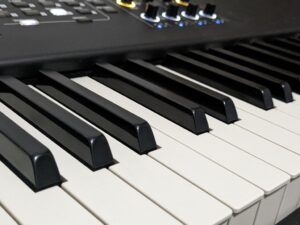 The only other things this Studiologic digital piano could have done in this model is to include a good internal speaker system, wav and MP3 recording capability, a thumb-drive port to handle storage, and Bluetooth Wireless MIDI & Audio, as I already mentioned. But those additional feature would definitely have added more cost to the XGT. Beyond that I would have liked if the key action was a lot less “thumpy” so that the key action noise would not be as noticeable. Also I would have preferred if the black keys were a little less heavy to play to better match the white keys as far as touch-weight. Overall the key action is enjoyable to play (with the exception of the thumpy action noise), but those things are improvements that would be good to have.
The only other things this Studiologic digital piano could have done in this model is to include a good internal speaker system, wav and MP3 recording capability, a thumb-drive port to handle storage, and Bluetooth Wireless MIDI & Audio, as I already mentioned. But those additional feature would definitely have added more cost to the XGT. Beyond that I would have liked if the key action was a lot less “thumpy” so that the key action noise would not be as noticeable. Also I would have preferred if the black keys were a little less heavy to play to better match the white keys as far as touch-weight. Overall the key action is enjoyable to play (with the exception of the thumpy action noise), but those things are improvements that would be good to have.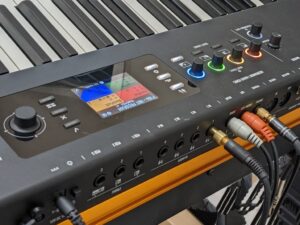 It’s easy to “pick apart” a digital piano because being “picky” is fairly easy if you try. But…given this model does what it does, and works the way it works, and looks the way it looks…it’s a “slam-dunk” for me as far as recommending it to anyone who wants great sounds, great control, and a piano style key action that is actually much better than I thought it would be, and far beyond the average portable studio digital piano. In fact, I think the XGT is under-priced for what it is and should be more like $2499 instead of $2199. I really enjoyed my playing experience with it (minus the thumpy key action) and it was exciting for me that I could make and play inspiring music I was hoping I could do on this model. I would definitely put it in a “premium” category with the very cool features that it has.
It’s easy to “pick apart” a digital piano because being “picky” is fairly easy if you try. But…given this model does what it does, and works the way it works, and looks the way it looks…it’s a “slam-dunk” for me as far as recommending it to anyone who wants great sounds, great control, and a piano style key action that is actually much better than I thought it would be, and far beyond the average portable studio digital piano. In fact, I think the XGT is under-priced for what it is and should be more like $2499 instead of $2199. I really enjoyed my playing experience with it (minus the thumpy key action) and it was exciting for me that I could make and play inspiring music I was hoping I could do on this model. I would definitely put it in a “premium” category with the very cool features that it has.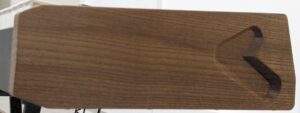 I also asked a few other pro piano players that I know to play the XGT and they felt the same way, especially when playing the acoustic grand and vintage electric piano sounds…they thought those sounds were really good and very expressive. So, there it is, a fairly exhaustive review of the Studiologic XGT and its “stand-alone” abilities. There are some “controller” aspects of this model I did not cover and that’s because my brain was hurting after covering this much detail. If you want to know more then look at the specs and try it out for yourself if you can find one.
I also asked a few other pro piano players that I know to play the XGT and they felt the same way, especially when playing the acoustic grand and vintage electric piano sounds…they thought those sounds were really good and very expressive. So, there it is, a fairly exhaustive review of the Studiologic XGT and its “stand-alone” abilities. There are some “controller” aspects of this model I did not cover and that’s because my brain was hurting after covering this much detail. If you want to know more then look at the specs and try it out for yourself if you can find one.If you want more info on new digital pianos and LOWER PRICES than internet discounts or Amazon, please email me at tim@azpianowholesale.com or call direct at 602-571-1864.
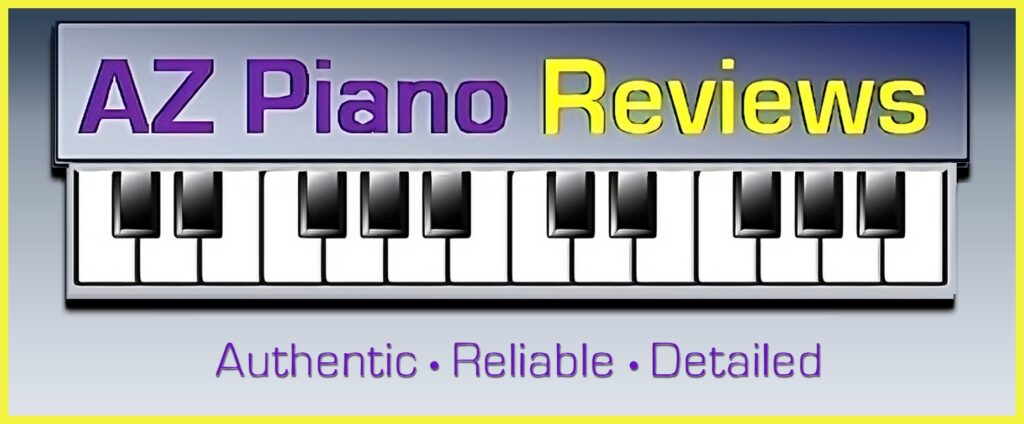


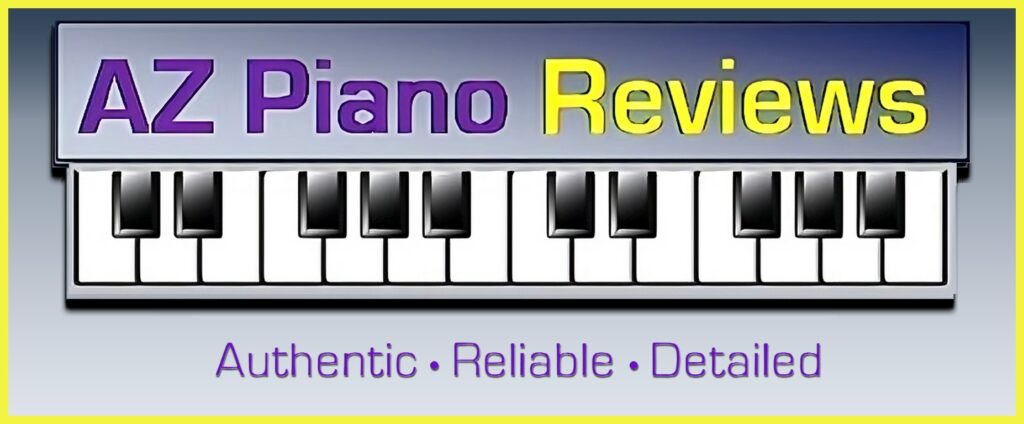


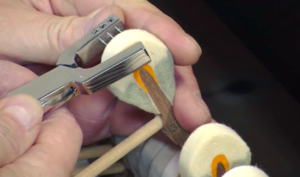
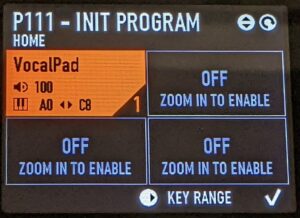
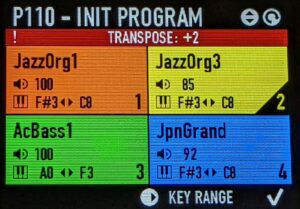
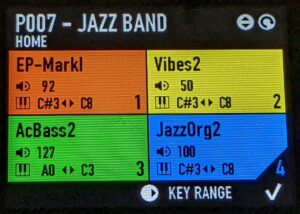
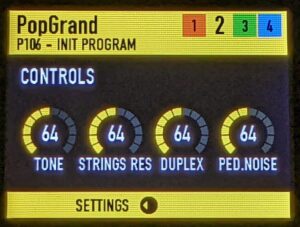
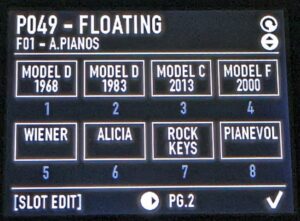



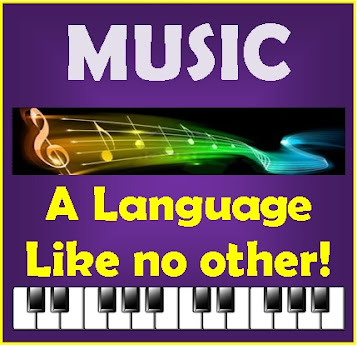

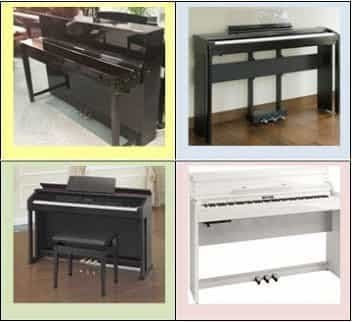



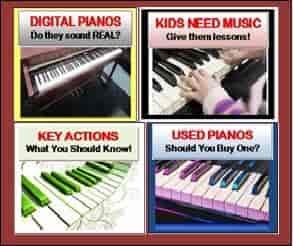
Hi, thank you for this big review of the xgt that i'm actually waiting. The only thing that i'm afraid is the sound of the key. You say that the Keys are noisy. However, in other forums I had read that this was not the case. With your review i'm really afraid because the silent is important for me. Do you know witch keyboard like xgt is silent ? Thank you.
Please which has better piano action Kawaii VPC1 or this Numa Piano X GT? Thanks
The best review I’ve seen so far! Congratulations on the work. You definitely covered all aspects of the XGT.